#Simulation and Test Data Management
Explore tagged Tumblr posts
Text

Love Letter
Pairing: Oscar Piastri x Felicity Leong-Piastri (Original Character)
Summary: Other people write love letters, Felicity Piastri reengineers tire degradation.
Notes: Big thanks to @llirawolf , who actually knows what she is talking about and is the genius behind the science. She said this science "was understandable and accurate enough for fic." (Also I am aware that this is not believable, but hey, let me have fun 😂
(divider thanks to @saradika-graphics )

By the time McLaren hit mid-season in 2024, Andrea Stella had become something of a veteran in the art of bracing for impact — the kind that came not from a crash, but from the Piastri household.
He had gotten used to it.
Oscar’s precision. His unnerving calm. The way he drove with the composure of a man triple his age and none of the ego.
Felicity, who wasn’t technically on the payroll, but might as well have had a desk in R&D. Who was so liked in the engineering department that Andrea had overheard an engineer asking Oscar like an overexcited puppy when his wife was going to come back and play with them.
Felicity was always lingering at the edge of a race day.
Always watching. Always noticing.
And then there was Bee — small, serious, and so wildly intelligent it made his engineers nervous. She had literally seen an issue with their suspension during her first trip to the garage. Now, she asked about downforce balance mid-lunch and then drew airflow diagrams on her juice box.
Andrea had learned to expect brilliance from them.
But what Felicity handed him that morning wasn’t brilliance.
It was revolution.
It came in the form of a single-page drawing.
A3 paper. Hand-sketched. Neat annotations in clean block lettering.
She passed it over casually, like it was a grocery list. “Was thinking about deg last night. Couldn’t sleep. Just a theory. Don’t know if it’s actually useful, sorry.”
Andrea glanced at it.
Then really looked.
And stopped breathing.
At first glance, it looked like a cooling solution — rim cooling, a variation on brake duct design. Not uncommon. Not radical.
But then he saw it.
Phase. Change. Materials.
His eyes darted to the margin where she’d written:
PCM core set to activate at 276°C. Peak drawdown window ~30 seconds, reset threshold <210°C. Tapered air channel design for directional retention. Modeled after CPU heat-sink transfer.
Andrea looked up.
Felicity just shrugged. “Everyone’s been trying to brute-force cooling through airflow. I figured… maybe it’s not about keeping it cool. Maybe it’s about controlling the peak.”
It wasn’t theoretical.
It was elegant.
Andrea’s brain kicked into high gear.
PCM — phase change materials — had been a whispered concept in F1 circles for years. The holy grail of thermal management.
The idea that you could insert a material that would melt in response to a precise temperature range, absorbing energy as it changed state — holding a system in a stable thermal window. It worked in CPUs. Data centers. Rocketry.
But no one had ever made it viable in an F1 brake drum environment.
Not until now.
Not until this.
Not until it came from Oscar Piastri’s wife, at 2 a.m., in the quiet space between insomnia and motherhood.
Andrea blinked hard. “You know we’ve had engineers — PhDs — trying to crack this for years?”
She just shrugged.
He had no words.
Just respect.
And the rising sense that something seismic had shifted.
He handed it straight to the sim team. They ran a closed simulation. Quietly. Then another. And another.
By the time they tested it under controlled parameters, the engineers were whispering about windowed degradation curves. About temperature floors. About thermal consistency that shouldn’t be possible.
Oscar was suddenly able to manage medium compounds like they were hard. The performance drop-off curve flattened — flattened. Andrea had never seen anything like it.
No magic bullet in F1 ever worked this fast.
But this?
This wasn’t a magic bullet.
It was physics. It was material science. It was control — without compromise.
They ran it again during a private test at Silverstone. And then — stealthily — implemented portions of the system into the race package.
By the time the 2025 season came around, Red Bull was accusing them of cheating. Mercedes was sulking. Ferrari was confused.
The paddock wanted to know what the hell McLaren had done.
The answer?
Felicity Piastri.
When Andrea called her into his office, holding the latest race run data in one hand and a calculator in the other, she sat across from him sipping tea out of a mug with Bee’s name on it.
“You realize you’ve just solved one of the biggest unsolved problems in modern F1?” he said.
Felicity blinked. “I was just tired of watching Oscar hemorrhage tire life while driving perfectly.”
Andrea stared at her.
She added, a little awkwardly, “I didn’t… mean to change the whole season. I just wanted him to stop overcompensating for a thermal flaw no one was fixing.”
Andrea leaned back in his chair and said — for the first time in his career — “I am both terrified of and completely in awe of your entire family.”
Felicity just smiled and said, “Would you mind printing a copy of the new tire envelope profiles? Bee wants to compare the heatmaps to the old ones.”
Andrea buried his face in his hands. “Tell her to go easy on us.”
“I’ll try. No promises.”
They were rocket ships now. Every track. Every compound. Consistent, controlled, deadly fast.
And somewhere, deep in the McLaren server, the drawing still existed. In a scanned file. Named Piastri_Insomnia_Fix_v1.pdf
Andrea renamed it later that week.
"Found the Window."
Because that’s what it was.
A window — held open by a woman who thought differently. Who didn’t need the spotlight. Who just loved someone enough to stay up all night figuring out how to protect him from heat, chaos, and failure.
And somehow, she’d done the same for all of them.
***
Mark Webber had seen a lot in his career.
Title deciders. Broken bones. Politics dressed up as progress. He’d seen technical miracles and driver meltdowns and the rare, perfect moment when both came together and worked.
But he had never seen a technical revolution arrive folded in half on a single piece of A3 paper, annotated in gel pen and handed in like someone had just scribbled down the grocery list.
And he certainly hadn’t expected it to come from Felicity Piastri. Maybe he should have.
He was standing trackside in China when Andrea Stella handed him the printout — not the PDF version with simulations, but the original. The drawing. The one that changed their 2025 season from promising to dominant.
“She gave me this on a Tuesday,” Andrea said, voice flat with disbelief. “Said it was just a thought. I’ve had people with entire departments fail to model this. She did it because she couldn’t sleep.”
Mark turned the page over once. Then again.
It was neat. Clean. Not showy.
Pressure curves, airflow vectors, the highlighted activation band of the phase change material she’d used to stabilize tire temp near the brake drum.
“Jesus Christ,” he muttered. “She’s a genius.”
He knew that. He had been aware of it for years. But it was something else entirely to see it in action.
Andrea didn’t argue. “She just… wanted to help Oscar.”
Mark stared at the drawing again.
That’s when it hit him.
This wasn’t a flex.
This wasn’t about glory. Or proving herself. Or showing up a paddock full of men with degrees and dynos.
It was a love letter.
Written in airflow.
Signed in melting point theory.
Stamped in the stable temperature range of a tire that could now go ten laps longer without falling off.
Felicity hadn’t just solved degradation.
She had — quietly, brilliantly — rewritten the way Oscar raced.
Because he was hers.
And this was what loving him looked like.
Not flowers. Not poems. Just… making the world easier for him. A little softer. A little kinder. A little less brutal at 300km/h.
Mark let out a slow breath.
“Do you think she knows what she did?” he asked.
Andrea shrugged. “I think she knows why she did it. That’s probably enough.”
Mark folded the paper again — carefully, reverently — and tucked it back into the folder.
And in that moment, he didn’t see the terrifying engineering breakthrough.
He just saw a woman who loved her husband enough to change the laws of tire life —So he wouldn’t have to carry the weight alone.
***
Oscar had just come back from a long run on used mediums when Andrea called him into the office.
Nothing dramatic — just a quiet, “Got a sec?” as Oscar peeled off his gloves and handed his helmet to a mechanic. The kind of thing that sounded normal. Routine. Like maybe they were going to go over sector data or tire drop-off or which curb had tried to kill him today.
So when Andrea closed the office door behind them and reached into his drawer without saying a word, Oscar raised an eyebrow.
Then Andrea handed him a sheet of paper.
A3. Slightly folded. Faint graphite smudges along the margin.
The original one. Still folded along the crease Felicity had made when she handed it to Andrea like it wasn’t the single greatest thermal breakthrough in modern tire strategy.
Oscar took it automatically.
Looked down.
And stilled.
There were notes in clean block print. Equations. Angled airflow paths, subtle thermal gradients, annotations on phase change material melt points and rim temperature drawdown.
Oscar’s throat went dry. His eyes scanned the drawing again, heart starting to race—not from adrenaline, but from recognition.
He knew that handwriting.
It was so her. The tidy script. The neat arrows. The absence of drama.
Just a brilliant mind trying to fix something that made the person she loved suffer.
He’d seen it on post-it notes stuck to Bee’s whiteboard. On margin scribbles in books Felicity had left lying around. On every note she slipped into his suitcase before he went to a race….every note that he then slipped into his racing gloves.
Oscar looked up, voice quieter than it should’ve been. “This is Felicity’s.”
Andrea nodded once. “She gave it to me three months ago. Said it was probably nothing. Just an idea she had when she couldn’t sleep.”
Oscar sat down.
Because suddenly, his knees weren’t quite up to the task.
He stared at the drawing like it might vanish.
This was it.
The fix. The reason their tires held. The reason he didn’t fall off in stint two. The reason strategy meetings had shifted from damage control to aggression. The reason the car felt like it trusted him back for the first time in forever.
He felt it like a punch to the chest.
“She… she did this?”
“She did,” Andrea said. “And she didn’t want credit. Said she just wanted you to stop overcompensating for bad thermal management. That you were too good to keep bleeding lap time for other people’s mistakes.”
Oscar swallowed hard. His hands were shaking.
He looked back down at the paper.
At the numbers.
The calculations.
Oscar turned the page over.
A post-it was pressed to the back, Andrea’s handwriting.
“From Mark: ‘This isn’t just engineering. This is her love letter to Oscar — making the world around him easier.’”
Oscar’s heart stopped.
He stared at the sentence for a long, long time.
He read it again. And again.
The words didn’t feel like compliments.
They felt like someone had taken a flashlight and pointed it directly into his chest — illuminating something he hadn’t dared to articulate, even to himself.
Because that’s what it was, wasn’t it?
The sketch. The concept. The whole damn thing.
Felicity hadn’t set out to change a season.
She’d just wanted him to stop hurting.
To stop watching his tires fall apart under perfect driving. To stop fighting physics he couldn’t control. To stop carrying all that frustration on his own.
She’d stayed up at 2 a.m. not because it was her job — but because it was his dream.
She had never once made him feel like he had to win for her.
But God, she made him believe he could.
He blinked hard.
Thought about the way she kissed his temple when he came home late. The way she labeled Bee’s lunchbox with thermal guidelines for optimum snack temperature. The way she never said I love you like a performance — only like a truth.
Then he looked up. “Mark… he really said that?”
Andrea’s voice gentled. “He did.”
Oscar stared at the page again.
“Yeah,” he said hoarsely. “Yeah. That’s her.”
And in his chest, where the engine noise usually lived — Where the pressure, the expectations, the sheer weight of competition settled — He felt something loosen.
Because winning was nice. The championship would be incredible.
But this?
Being loved like this?
That was better than anything he’d ever drive for.
***
The house was dark when he got home.
Not silent — not entirely. There was the low whir of the dishwasher. The cluck of a chicken outside, ruffling in its sleep. The soft creak of floorboards as he kicked his shoes off at the door and padded down the hall in his socks.
It was late. He hadn’t texted. He hadn’t needed to.
The bedroom door was open.
Bee was curled up in the middle of the bed like a starfish in mismatched pajamas, one hand still clutching the tail of her stuffed frog. Felicity was beside her, lying on top of the duvet, eyes closed, one arm slung across Bee’s little body like she was anchoring her in a dream.
Oscar stood in the doorway for a long time.
Just… watched them.
His wife and his daughter. One terrifying genius and one tiny one-in-training. Both of them unknowable and brilliant and his.
He swallowed around the knot in his throat and moved quietly to the other side of the bed, careful not to wake Bee as he lay down beside them.
Felicity stirred almost immediately, her breath catching as her body registered the warmth beside her.
Her eyes opened — drowsy, soft.
“Oz?” she murmured, her voice rough with sleep. “You’re home late.”
Oscar didn’t answer at first. Just slid his hand beneath hers and laced their fingers together. His thumb brushed over the back of her hand, slow and steady.
She didn’t push.
Didn’t sit up.
Didn’t ask.
Just waited.
And because she didn’t ask — because she already knew — he found his voice again.
“Mark saw the drawing,” he said, barely more than a whisper. “The one you gave Andrea.”
Felicity blinked slowly. “Oh.”
“He said it was a love letter. That you were making the world easier for me.”
She was still for a beat.
Then: “He’s not wrong.”
Oscar exhaled sharply. Pressed his forehead to her shoulder. “You didn’t have to do that.”
“I know.”
“I would’ve figured something out eventually.”
“I know.”
“But you did.”
She turned her head just enough to press a kiss to the crown of his hair.
Her voice was quieter than ever. “I’d do it again.”
Oscar’s breath hitched.
“I’d do it again tomorrow,” she said. “And the next day. And the day after that. If it meant you could breathe easier. If it meant you didn’t have to fight so hard just to keep pace with people who were working with better tools.”
He closed his eyes. Let the weight of her words settle over him like a blanket. Warm. Certain. Steady.
She ran her fingers through his curls once, twice.
And then she whispered: “You make the world easier for me, too. You just don’t notice it. You make it softer.”
Oscar kissed her shoulder. Didn’t move.
Didn’t need to.
Because she knew.
And he’d carry that with him — into every debrief, every qualifying lap, every moment on the podium.
This wasn’t just about racing.
This was home.
And it felt a hell of a lot like winning.
***
Lando found out in the most Lando way possible: completely by accident and one week too late.
He was in the simulator debrief when the topic of “thermal management integrity stability” came up — words that immediately made him want to die a little inside.
They were talking about their tire performance. Again.
Specifically, the fact that they could now absolutely cook it through mid-stint without falling off the cliff. And no one else could.
Lando was half paying attention — until one of the engineers muttered something about “F. Piastri’s material integration concept.”
Lando blinked.
“Sorry, whose what now?”
The room went quiet.
Andrea didn’t even look up from his screen. “Felicity. The drawing. You’ve seen it.”
“No, I have not seen it. Unless it was attached to a meme or came with a side of banana bread, I was not included.”
Will Joseph — Lando’s race engineer — slowly slid a printed diagram across the table.
Lando took one look.
Paused.
And said, “Wait. This is her?”
Andrea nodded without looking up. “Came up with it over insomnia. Gave it to me like it was a shopping list. It works.”
Lando stared at the airflow map, the PCM trigger temperatures, the annotated note that literally said ‘the goal is to stabilize the moment he usually starts slipping — give him room to breathe.’
He felt like someone had sucker-punched him with science and sentiment at the same time.
“Wait, wait, wait,” he said, sitting up straighter. “You’re telling me Felicity Piastri — as in, Oscar’s wife who wears motor oil like perfume and once fixed the coffee machine with a literal wrench — came up with the strategy that made our car an actual rocket ship?”
“Yes.”
“And it works.”
“Yes.”
“And she just gave it to you? No credit, no fuss, just… ‘here, I fixed the entire concept of high-deg tire strategy because I couldn’t sleep’?”
Andrea finally looked up. “Correct.”
Lando sat back, stunned.
He knew Felicity was scary smart. Knew she could rebuild a gearbox while calculating orbital velocity. Knew Oscar worshipped the ground she walked on and never made a big deal out of it because he didn’t need to.
But this?
This was something else.
“She didn’t do it for the team,” Lando said quietly, the realization hitting all at once. “She did it for him.”
Andrea didn’t say anything.
Didn’t have to.
Lando looked back down at the page — the margins, the equations, the gentle note that said “he’s too good to be held back by bad thermal behavior.”
And he felt it in his chest — that familiar ache.
Because that wasn’t engineering.
That was love.
The quiet kind.
The kind that doesn’t shout or show off.
The kind that stays up at 2 a.m. fixing something no one else thought could be fixed — just so the person you love can breathe easier.
So he doesn’t have to carry it all alone.
So he can go faster, safer, freer.
It was a love letter.
Not in flowers or poems.
In airflow and melting points.
Lando leaned back in his chair and exhaled. “Jesus Christ. She built him a better world.”
Will snorted. “She rebuilt tire degradation, but sure, let’s make it poetic.”
Lando didn’t even blink. “It is poetic. He’s the quiet guy. And she’s the quieter genius who knows exactly where he hurts and rewrites the laws of physics to help him anyway.”
Andrea tilted his head. “You’re getting sentimental again.”
“I’m right,” Lando shot back, still staring at the page. “He’ll win the title because she didn’t want him to bleed for it.”
He tapped the margin with his knuckle. “This is the kind of love that never asks for a podium. Just builds the car to get him there.”
And for once — no one had a comeback.
Because they all knew it was true.
***
They were in the driver’s lounge two days later, when Lando struck.
He’d been waiting for the perfect moment.
And Oscar, blissfully unaware, had just taken a bite of his protein bar like he wasn’t about to get emotionally roasted.
Lando stretched out across the sofa like a cat in a sunbeam and said, far too casually, “So… what’s it like being loved so much your wife reinvented tire degradation for you?”
Oscar blinked mid-chew. “…Sorry?”
Lando grinned. “Just curious. I mean, some of us get love letters or handmade birthday cakes. You? You get full-phase material integration strategies and temperature-controlled brake ducting. Romantic stuff.”
Oscar groaned, immediately regretting not hiding in the sim room instead. “Lando.”
“I’m serious,” Lando said, sitting up now, fully energized. “Felicity took one look at your stint data and said, ‘this man needs help. Let me just rewrite thermodynamics real quick.’”
Oscar rolled his eyes. “It wasn’t—”
“No, no,” Lando cut in. “Don’t you dare downplay this. The rest of us? We have to manage deg. You? You have a thermodynamic guardian angel in your marriage bed.”
Oscar flushed, the tips of his ears visibly pink. “She had a theory. That’s all.”
“‘Just a theory,’” Lando mimicked, using air quotes. “‘Just a casual bedtime sketch that turned McLaren into the most stable tire platform on the grid.’ My God, Oscar. She loves you so much it’s physically measurable.”
Oscar sank lower in his seat, muttering, “You’re insufferable.”
“You’re married to the Nikola Tesla of tire temp control. I deserve to be insufferable.”
“Lando—”
“She built us a better car because she hated watching you suffer.” Lando flopped dramatically. “Imagine. Being loved with that level of efficiency. Can you even comprehend?”
Oscar sighed, rubbing a hand over his face. “She’s just… always been smarter than all of us.”
Lando stopped mid-rant.
And smiled, softer this time. “Yeah. I know.”
There was a long pause.
Then Lando added, “Anyway. If she ever wants to fix my brakes, tell her I’m emotionally available.”
Oscar snorted. “Absolutely not.”
“What about Bee? Can she be bribed with juice boxes and data sets?”
Oscar shook his head, laughing now. “She’s already running her own simulations. She’s got standards.”
Lando grinned. “Just like her mum.”
Oscar looked down at the McLaren logo on his hoodie — the one Felicity stole all the time — and felt something warm settle in his chest.
He didn’t say anything else.
He didn’t need to.
But when he went home that night, he kissed Felicity extra softly — and whispered thank you against her temple like a promise.
And Felicity?
She just smiled, wiped her grease-smudged fingers on her jeans, and said, “Don’t thank me yet. Bee thinks we can improve the airflow angle by three degrees.”
Because love — in their house — was always a work in progress.
And always worth the effort.
***
#formula 1#f1 fanfiction#formula 1 fanfiction#f1 smau#f1 x reader#formula 1 x reader#f1 grid x reader#f1 grid fanfiction#oscar piastri fanfic#oscar piastri#Oscar Piastri fic#oscar piastri x reader#oscar piastri imagine#op81 fic#op81 imagine
862 notes
·
View notes
Text
Student Experiments Soar!
youtube
Have you ever wondered what it takes to get a technology ready for space? The NASA TechRise Student Challenge gives middle and high school students a chance to do just that – team up with their classmates to design an original science or technology project and bring that idea to life as a payload on a suborbital vehicle.
Since March 2021, with the help of teachers and technical advisors, students across the country have dreamed up experiments with the potential to impact space exploration and collect data about our planet.
So far, more than 180 TechRise experiments have flown on suborbital vehicles that expose them to the conditions of space. Flight testing is a big step along the path of space technology development and scientific discovery.
The 2023-2024 TechRise Challenge flight tests took place this summer, with 60 student teams selected to fly their experiments on one of two commercial suborbital flight platforms: a high-altitude balloon operated by World View, or the Xodiac rocket-powered lander operated by Astrobotic. Xodiac flew over the company’s Lunar Surface Proving Ground — a test field designed to simulate the Moon’s surface — in Mojave, California, while World View’s high-altitude balloon launched out of Page, Arizona.
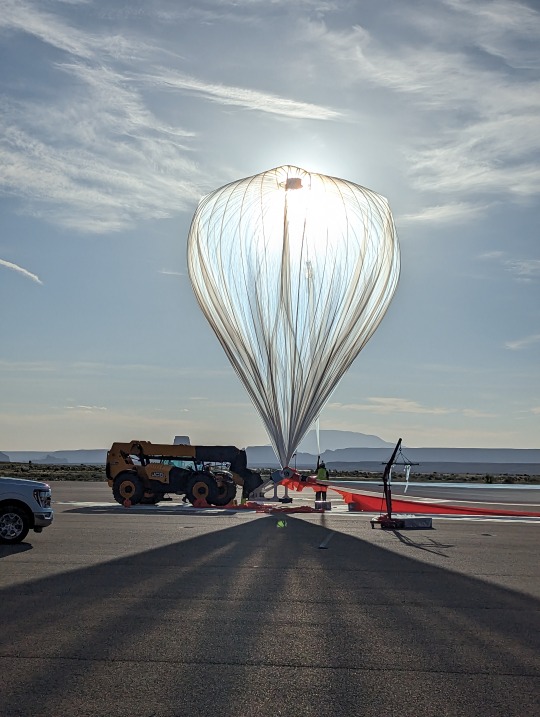

Here are four innovative TechRise experiments built by students and tested aboard NASA-supported flights this summer:
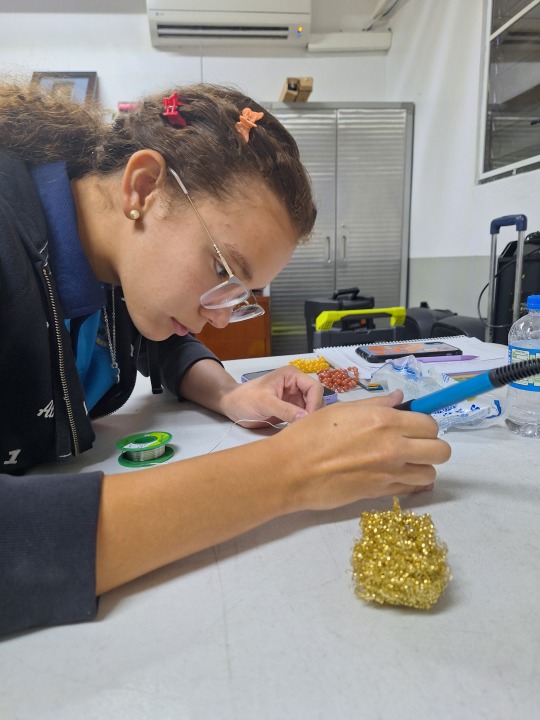
1. Oobleck Reaches the Skies
Oobleck, which gets its name from Dr. Seuss, is a mixture of cornstarch and water that behaves as both a liquid and a solid. Inspired by in-class science experiments, high school students at Colegio Otoqui in Bayomón, Puerto Rico, tested how Oobleck’s properties at 80,000 feet aboard a high-altitude balloon are different from those on Earth’s surface. Using sensors and the organic elements to create Oobleck, students aimed to collect data on the fluid under different conditions to determine if it could be used as a system for impact absorption.

2. Terrestrial Magnetic Field
Middle school students at Phillips Academy International Baccalaureate School in Birmingham, Alabama, tested the Earth’s magnetic field strength during the ascent, float, and descent of the high-altitude balloon. The team hypothesized the magnetic field strength decreases as the distance from Earth’s surface increases.
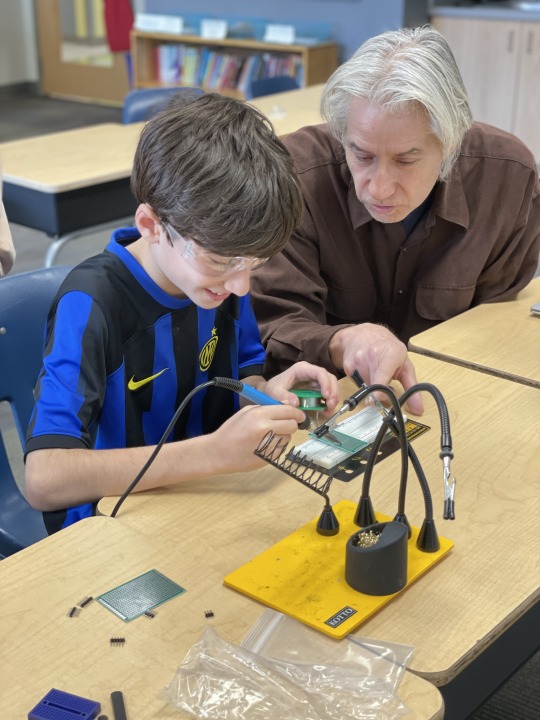
3. Rocket Lander Flame Experiment
To understand the impact of dust, rocks, and other materials kicked up by a rocket plume when landing on the Moon, middle school students at Cliff Valley School in Atlanta, Georgia, tested the vibrations of the Xodiac rocket-powered lander using CO2 and vibration sensors. The team also used infrared (thermal) and visual light cameras to attempt to detect the hazards produced by the rocket plume on the simulated lunar surface, which is important to ensure a safe landing.
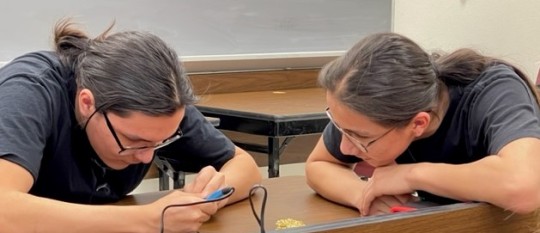
4. Rocket Navigation
Middle and high school students at Tiospaye Topa School in LaPlant, South Dakota, developed an experiment to track motion data with the help of a GPS tracker and magnetic radar. Using data from the rocket-powered lander flight, the team will create a map of the flight path as well as the magnetic field of the terrain. The students plan to use their map to explore developing their own rocket navigation system.
youtube
The 2024-2025 TechRise Challenge is now accepting proposals for technology and science to be tested on a high-altitude balloon! Not only does TechRise offer hands-on experience in a live testing scenario, but it also provides an opportunity to learn about teamwork, project management, and other real-world skills.
“The TechRise Challenge was a truly remarkable journey for our team,” said Roshni Ismail, the team lead and educator at Cliff Valley School. “Watching them transform through the discovery of new skills, problem-solving together while being driven by the chance of flying their creation on a [rocket-powered lander] with NASA has been exhilarating. They challenged themselves to learn through trial and error and worked long hours to overcome every obstacle. We are very grateful for this opportunity.”
Are you ready to bring your experiment design to the launchpad? If you are a sixth to 12th grade student, you can make a team under the guidance of an educator and submit your experiment ideas by November 1. Get ready to create!
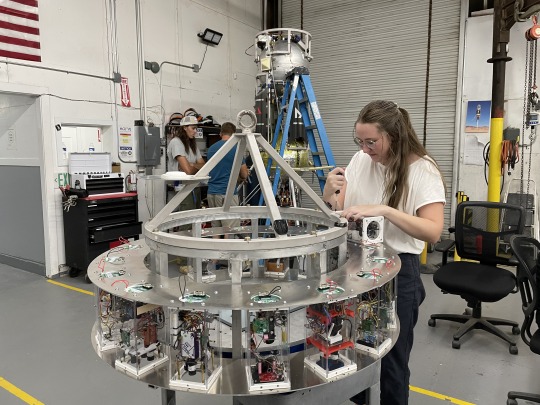
Make sure to follow us on Tumblr for your regular dose of space!
613 notes
·
View notes
Text
All American
Summary: An all American team on the grid.
Pairing: Logan Sargeant x reader, Max Verstappen x reader (breifly), Carlos Sainz x reader (breifly), Oscar Piastri x reader (briefly)
Word Count: 1.6k
Masterlist
Logan Sargeant Masterlist
Tag List
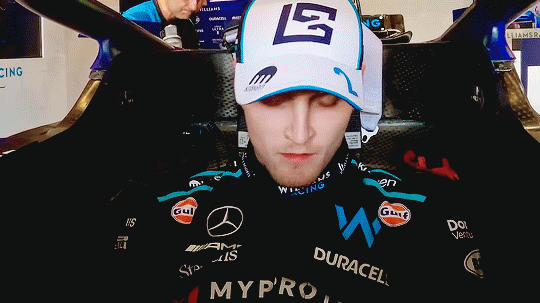
Logan’s year in formula one hadn’t ended the best, but neither had yours. Logan was dropped by Williams Formula One Racing whereas you had been dropped by Arrow Mclaren due to an injury at the end of the indycar season that meant you’d missed too many races and it was in your contract that you couldn’t miss more than four races.
However, for you, being dropped by Arrow was probably the best thing that had ever happened because Andretti was allowed into Formula One. Offering you a place within formula one after your ‘Great work in Indycar’ you couldn’t help but accept the offer. Working with an American company also helped you decide.
Your first meeting in the Andretti office allowed you to meet your new team, your mechanics, your race engineer, your performance engineer, PR manager and everyone else who’d be surrounding you for most of the year. Your teammate wasn’t decided at this point, though.
However, when you went back for simulation testing, your new race engineer and performance engineer were waiting for you. Except your new teammate was also doing some simulation testing. Logan Sargeant.
You smiled over to him as you sat in the simulator. You were glad to see that he also got a second chance at racing. You knew he was a good driver. Just Williams didn’t have any trust in him, and the car wasn’t showing enough performance for him.
However, your simulation testing was a little different. Andretti knew you could reach the times they were looking for; they just wanted to ensure that after your injury you’d be ready to race by the time the new season started. Once both yours, and logan's teams had left, you walked over to him to see him practising
“Hey there” You smiled, leaning on the back of his seat
“Hey” He looked up with a smile
“So were teammates now huh” You smiled, and he nodded
“Yeah I guess so. What happened with Mclaren?” He asked. Motorsports in America wasn’t a big thing, so most drivers knew yeah other
“Broke my wrist and took longer than four races to heal, so they terminated my contract. I was mad at first. Fans were more than mad, but it’s in my contract. Getting injured isn’t on anyone’s agenda” You shrugged, looking at his data.
“Anyway keep testing” You hummed watching as he raced around Melbourne.
“I hate Melbourne” He mumbled, and you nodded
“Change your racing line a little. Turn two try to come off the brakes a little later. How’s your stats been racing here before?” You asked
“Twenty-three. I DNFed and twenty-four I got my car taken off me” He explained, and you nodded
“When was the last time you raced here?” He asked
“I did some testing for Mclaren two years ago? When I was their reserve driver but that was ages ago. Sim work every day almost though” You shrugged, and he nodded.
“I guess that makes sense” He shrugged, and you nodded.
“Oh look at that. See my tips work” You joked, walking over to grab your bag from your sim
“Thanks. Any more tips?” He asked, and you shook your head
“Not for Melbourne. When we move on, give me a shout” You hummed. Walking out of the simulator, you walked down to the cafeteria. The best thing about joining an American company is that although you were on diets to keep your body correct while racing, they still make the best typical American food even if it’s diet themed.
Thanking the woman behind the counter, you took a plate sitting down at one of the tables. Scrolling on your phone as you ate the chicken and rice. You hadn’t been announced for Andretti yet, but neither had Logan. They were waiting for the right time, apparently.
Although speaking to your race engineer, they wanted to wait until pre-season testing, but the FIA wasn’t allowing that. It had to be announced at least a month before pre-season testing. Posting a picture of the simulator on instagram, you closed the app, opening up the group chat where you streamed with a few friends, including Max Verstappen.
They were planning on streaming, but due to your training for going into Formula One. Looking up, Logan was sitting in front of you with his own plate of rice and chicken.
“This is so much better than Williams” He chuckled, and you laughed
“Yeah well first of all they’re British. Second of all it’s rice and chicken” You tilted your head to look at him.
“What’s your plan for this afternoon?” He asked
“Meeting with my performance engineer. She wants me to start my neck training” You huffed, and he laughed.
“Neck training isn’t that bad” He shrugged
“Yeah I know. I don’t mind neck training it’s just my friends have plans, and I’m missing it to torture my neck” You shrugged, and he nodded
“Fair enough. How are you feeling about coming on the grid?” He asked, and you looked at him. It’s something you’d never thought about
“Well. I’ve never actually thought about it, to be honest with you. I know Lando, Daniel, Carlos, Oscar, and Max, so I guess knowing some people helps? I obviously know Pato as well” You shrugged
“Yeah, getting to know people really does help. It’s my biggest regret hiding in the Williams garage and not getting to know new people” You nodded with a small smile
“Well let’s make a deal. This year. You and I make as many friends as possible. I know Max and Daniel are troublemakers, so they’ll make sure I get to know people, so you’ll just have to follow me about” You shrugged with a smile, and he chuckled
“That’s a deal L/N”

A month later and you were now on the grid for pre-season testing sat in the Andretti garage just minding your own business as you watched Logan doing the testing, obviously sandbagging because the bosses didn’t want to show off what the car was able to do just yet.
A flash of colour caught the corner of your eye as you looked over spotting a couple other drivers looking into Logan’s part of the garage which was open for all to see unlike your side which was blocked off due to the floor of your car was off.
Pushing the headphones so they rested around your neck,, you walked over to the group of drivers who were being nosey about the garage.
“Hello boys” You hummed tilting your head as you stood trying to figure out what they were looking at.
“Y/N” Max smiled, giving you a quick hug
“What are you all looking at?” You asked confused, causing Max and Daniel to shrug
“No idea. Lando and Carlos just started staring at something” You looked back into the garage to see mechanics just sitting about. You shrugged, putting the headphones back on your head, shoving one side off so you could listen to them talk.
“How’s your wrist?” Daniel asked
“How's yours?” You asked, and he chuckled
“Fair enough, but honestly, how is it?” He asked again
“Physio is going well. Simulator work is going okay, and I guess we’ll see how actually driving goes when I get out there tomorrow” You shrugged
“You’re not going out today?” Max asked, and you shook your head
“Logan does today, I do tomorrow, and we both do the third day” You explained
“Ferrari’s doing that as well” Carlos nodded with a shrug as you quickly jogged into the garage, hearing Logan’s panicked voice through the radio.
“Jesus” You mumbled while watching the TV. Someone stopped on track right as Logan was doing a flying lap, causing him to go into the gravel trap. His panicked radio broke your heart, hearing him ask if he had done something wrong and the fact he had hurt himself trying to save himself from crashing into someone else. Biting your lip as the rest of the drivers stood next to you watching the TV.
“What happened?” Oscar asked with a frown
“Someone stopped on track during his flying trap” You explained, watching their facial expressions change as you were called over to the pit wall. Jogging over and standing behind Logan’s race engineer and your team principal
“Change of schedule. Logan’s floor is damaged so you’re going out this afternoon” You nodded slightly walking back into the garage knowing that you’re going to have to get changed out of the nice comfortable uniform Andretti had provided.

Having changed into your fireproofs, you walked out to the garage to see the drivers talking to Logan. Walking over to him, you wrapped your arms around him from the side
“Hey, it’s not your fault. Don’t beat yourself up for it” You smiled up at him. Over the past month, you had become very close with Logan. Maybe a little closer than teammates should probably be, but you both had a lot in common, including being American.
“You’re going to do great though” He shrugged, and you looked him in the eyes
“Is your tongue okay? I heard you bit it” You frowned, and he nodded
“Yeah, it was bleeding a little, but by the time I got back here, it had stopped” He shrugged, and you nodded
“Okay” You nodded, accepting your equipment from your performance engineer. Most of the other drivers went back to their own garage.
As you put your earphones in and pulled the balaclava on your race engineer went over the plan for the afternoon. With a nod, you pulled your helmet on, ensuring it was tight before getting in the car. Pulling your gloves in as a mechanic placed your wheel in the car
“Radio check Y/N” They nodded
“Loud and clear” You smiled

Tag list
@bearryyy
@lozzamen3
@barcelonaloverf1life
@hiireadstuff
@f1kenzzz
@evie-119
@ahgase99
@velocesainz
@callsignwidow
#f1 imagine#f1 x reader#f1 fanfic#f1 fic#f1#f1 x you#formula one x reader#formula one x you#formula one x y/n#formula one smau#logan sargeant imagine#logan sargeant x reader#logan seargent#logan sargent x reader#logan sargeant#logan sargeant x you#ls2 fluff#ls2 fic#ls2 imagine#ls2 x reader#ls2
634 notes
·
View notes
Note
Last human au) jaune has been stuck in a cell since he was woken up and he's gonna be honest not the worst day he's ever had but not the best either although he might have just made a new friend. A robot friend at that!
Penny is sure she's managed to ingratiate herself with her new primitive charge. Poor thing probably doesn't even realize that she's not even a real human! She'll have to keep that a secret though even when he falls in love with her. For science of course. Now to learn more about the human and move him to the study area where friend ruby is waiting.
Basically jaune might be more modern but everyone around him doesn't know that yet. In order to keep him comfortable and not be cruel to the poor primitive thing they commissioned a robot companion to befriend him and guide him back to the testing area. Surely they'll be able to account for everything on the simulated escape and jaune won't outsmart them all before wandering off to the city
Tldr: jaune out smarts everyone and now they're panicking because what they think is a caveman is wandering around the city. On the plus side ruby feels validated in her idea that just because jaune is less educated than modern faunas doesn't mean he's less intelligent. And penny is getting all sorts of interesting data
Bedrock Bottom
First/Previous
Jaune had never been to jail before. He was raised to be polite and respectful to everyone around him, or else the police would take him away from his family. However, looking back on it, the stories he'd heard about prison were distinctly different from where he was now. These tales of horror and warning scared Jaune to know end, his father terrifying him with tales of endless gang wars, violent guards, and other inmates who would view him as a plaything to do what they would with him.
Except none of this was true from his perspective. Right now, it felt more like he was a pet rat kept in a shoebox. Food was brought to him three times a day, as well as books, puzzles, and the occasional "letter from home," which was just some girl pretending to be his mom and warning him to not stay out too late or else the "dire rats would gobble him up".
Speaking of strange girls, he wasn't alone in his room, either. Delivering these items was Penny, a cute girl with red hair that curled just above her shoulders. She would ask him questions about himself, then respond with "Oh, I know about that! That's what all humans do, right?" There was usually a hiccup between these statements.
It had been a week since he'd been tossed into his cell, and six days since Penny came into his life. He would spend most of the day sitting on his bed, reading between meals, though at some points, he would forgo the reading and do some exercises instead. Penny would sit on the bed regardless and ask him questions. Questions like...
"Why are you doing pushups the wrong way?"
"It's not the wrong way." Jaune answered. "I'm just exercising different muscles."
"Oh! I know about that!" She hiccupped. "That's what all humans do, right?"
"Not all of them." Jaune lifted himself to his knees. "Can I ask you something, Penny? Human to human?"
"Sensational!" Penny's eyes widened as much as her smile. She jumped from the bed, hopping from one foot to the other in a little dance. "I've successfully integrated with the human specimen~!"
"But aren't you human?" Penny stopped. "I mean, you are human, right?"
"Affirmative!" Penny said, then hiccupped. "I am a human meat person, just like you!" She hiccupped again.
"Uh-huh." He let the issue go for now. "Anyways, I was wondering what you did to get locked up in here."
"What I did?" Penny repeated.
"Yeah, this is a jail, isn't it?"
"...Yes!" She hiccupped.
"And prisoners are locked up in prison for doing bad things, right?"
"Yes, that is correct."
"I, er, broke out of a hospital and pushed a girl over, so I guess I got in trouble for some kind of hospital rule."
"...Oh! I know about that!" She didn't hiccup. "That's what all humans do, right?"
"No, it isn't, Penny."
"It... isn't?"
"Penny, you're my friend, right?"
"I... Am I?" She asked. She then got really close. Almost uncomfortably close. "Do you see me as a friend?!"
"I... Yes?" Penny was quiet for a moment. Then she was quiet for a moment longer. Suddenly, she beamed with the biggest smile he'd ever seen. "Uh, Pen-"
"SENSATIONAL!" She hugged him, and she was squeezing him REAL tight. "I cannot believe I have two friends, and one of them is the human!"
"Wait, wait." Jaune groaned from his strained lungs. "Who's... Who's your other friend?"
Penny gasped, then shut and covered her mouth with her hand. She quickly ran to the door, not looking back as she pounded on the cell entrance/exit. The door hissed and slid open, and a team of four, burly guards rushed in, knocking Jaune to the ground. Looking up, he saw Penny looking back. Her eyes were the saddest he'd ever seen. And then she ran away, and he was left pinned to the floor.
As she ran, he couldn't help but notice the twin antennae extending from her hair.
101 notes
·
View notes
Text
Sora: Expectations vs Reality (Coded vs KH1, CoM, and 3D)
Another Sora analysis because I can't help myself haha (help). But there's been a couple of posts that talked about this topic and it's really rewired my brain, so I also want to take a stab at it. I feel like this isn't something that's looked into/analyzed as much compared to other interpretations of KH's narrative, especially in terms of Sora, or at least I haven't seen it as much across platforms in a mainstream sense (though I do think it's been on the rise in recent times).
So if you're willing to bear with me, then get ready for another long post!
As the title indicates, and as mentioned, other people have brought up, Data-Sora creates an in-universe (and IRL) set of expectations for the actual Sora. While Coded is technically a rehash of KH1 and CoM's plot to an extent (hence its reputation besides its amazing gameplay), the point is to gather and present the stakes KH2, Days, and BBS introduced and set up what Sora's goals are going to be leading into 3D and 3.
The way it chooses to do so is to put a simulated Sora to the test, to see if he can "handle the hurt" and while he manages to do so, as many others have pointed out, Data-Sora's decision about remembering the pain to connect to others contradicts Sora's decision to forget at the end of CoM. Coded dictates that Sora can handle the pain of those within him and/or those who need to be saved. But 3D contradicts that as well. Many say that this indicates a potential point in Sora's development as a character and person, and while I agree, I want to focus on what has shaped him to this point in the first place. I must add, though, that Sora in 3, in terms of what he knows/is aware of by the end, understands a lot more than I've seen some people give him credit for, but this is another opinion in of itself.
Reading full-on long paragraphs might make this even harder to get through so I'll try to place some parts in bullet points (I get info-overloaded easily sometimes due to long paragraphs too ToT):
Coded, as said before, while initially having Data-Sora find/fix the missing/corrupted data in Jiminy's Journal (KH1 aspect), turns into a test to see if Sora can handle the "hurt" of the people he needs to save (CoM aspect).
Data-Sora proves he is willing to take on that "hurt" and can handle it. Which Sora by KH3/ReMind also manages to show.
But this neglects a few things about Sora's character before that point:
Data-Sora in the first part of Coded has guidance from Mickey, Donald, Goofy, and Data-Riku especially D and G who have experienced their KH1 development and are currently ride-or-die for him. The KH1 experience ends up being different for him.
Even though he fights Data-Riku, it can be chalked up to the bugs/possession rather than anything malicious, which contrasts with real Riku before the Ansem possession.
Data-Sora losing his keyblade happened due to Maleficent rather than Riku. Rather than Goofy and Donald leaving him, he's the one that storms off and even then they go after him.
When we get to the CoM portion, Data-Sora doesn't have his memories of what happened in the first half, hence he goes straight to Castle Oblivion without the KH1 experience (also he's initially guided by Mickey, Data-Riku, and Data-Roxas)
In this case, it's a test of strength rather than what happened in CoM where Marluxia and Larxene hoped to break Sora to make him their puppet.
Data-Sora went to the KH1 worlds in each room and was made to forget right after getting through each one
But Sora had his memories from even before the first game actively messed with, while also being made to believe that it was the real Riku attacking him. All of that happened without much guidance from anyone.
What this shows is that while Data-Sora is the ideal outcome of Sora's development, I think as a narrative that presents trauma (intentionally and unintentionally), it emphasizes what the real Sora has been through. Theoretically, had things gone differently for Sora, and he had a proper support system on these journies, he would have been able to make the "right" choice. But he didn't have that. He had to figure a lot of things out and had to pull himself through. In a way, it feels unfair to some extent and it creates the expectations vs reality aspect.
And I believe this comes to fruition in 3D:
Organization XIII successfully overwhelms Sora, his heart ends up breaking under the emotional stress of all the people he's connected to as he's pulled into deeper sleep.
It especially sucks considering that the Mark of Mastery Exam was actively messed with in an outright attempt to break Sora (again).
His failure of the exam makes sense considering he couldn't overcome the Darkness in this real-world application like Riku, but it leaves such a bitter taste, right?
(The logistics of the exam can be argued ngl. Isn't it wild that all cases of the exam we've seen have had an external force get involved and have irrevocable damage on the test takers? Taking lives and souls fr.)
So what we get is a failure of those expectations (at least initially). Reality is much more harrowing and vicious. And that's such an interesting thing to do narratively, it feels purposeful. It establishes a depth to Sora that isn't fully seen and even adds to the concept of Data-Sora being his own existence by extension. By KH3, Sora's low self-esteem is directly shown to us and stems from the reality of his journey. He has a lot of unaddressed scars and while the characters view him as a beacon of hope out of love and respect, many of us acknowledge how harmful that's been to him in the most specific ways.
I really, really hope that the upcoming games build on this and address it, because it'd be so satisfying to see all of this acknowledged and explored! It would feel fitting for Sora to go to Unreality and face the reality of himself.
(I'm sorry if this was incoherent, I'm bad at collecting my thoughts on the spot...I'm open to corrections and additional thoughts!)
#kingdom hearts#kh#kh sora#sora#character analysis#protagonists like sora are interesting because mainstream perspective can easily summarize them as the same-y typical shounen protag#but in my experience with deep-diving into character analysis for these kinds of characters there can be a purposeful (or not) case#placing them on pedestals (or hating them) in-universe and by the audience. and while not every series that does this explores it#time and time again people do notice it and i can't help but appreciate that.#many of these characters do have their own nuance and by being upbeat and/or simple-minded in general it gets pushed under the rug#purposefully or by flanderization/simplification#it's a fascinating phenomenon to contemplate and study in real time#yoroshiu analyzes
28 notes
·
View notes
Text
The Chrimer: 2016, GP3.
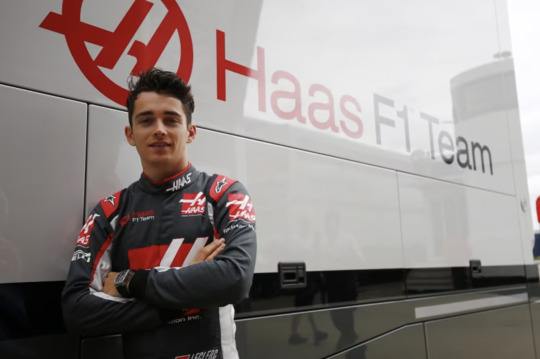
In 2016, Charles returns to ART Grand Prix as one of their GP3 drivers. This would be the first (and only) time he'd race under their name in single-seaters; previously, he had karted for the team in 2012 and 2013. It's a good team. By the time Charles joins the roster, they've come off of winning five teams' championships and three drivers' titles in just six seasons.
Their success isn't the only reason why this partnership is advantageous to Charles. It also puts him with some familiar faces.
ART GP was co-founded by two men that would be very integral to Charles' career: Nicholas Todt and Frederic Vasseur. Todt would be the manager that saved Charles' career in karts, and Vasseur would later be Charles' first F1 Team Principal.

In the press release, Charles says:
"I am delighted to be back with the big ART Grand Prix family after my karting seasons in 2012 and 2013. GP3 is a very competitive category and I will be in the best team in the championship. The atmosphere is good and everything everyone is working with a common goal: to win. I am excited about the car they have prepared for this season and I can't wait to start the championship. My objective is clearly to fight for the title."
GP3 would eventually be merged with the Formula 3 European Championship-- the category Charles had competed in the previous year-- to form present day F3. In 2016, however, GP3 was considered a minor step up from F3: the cars were a little faster, and the tires were a little more difficult to master.
Somehow, Charles' announcement that he would be graduating to GP3 with the top team wouldn't be his biggest press release of the week.
On March 1st, Ferrari formally announces Charles as the newest member of the Ferrari Drivers Academy. This had been rumored for months.
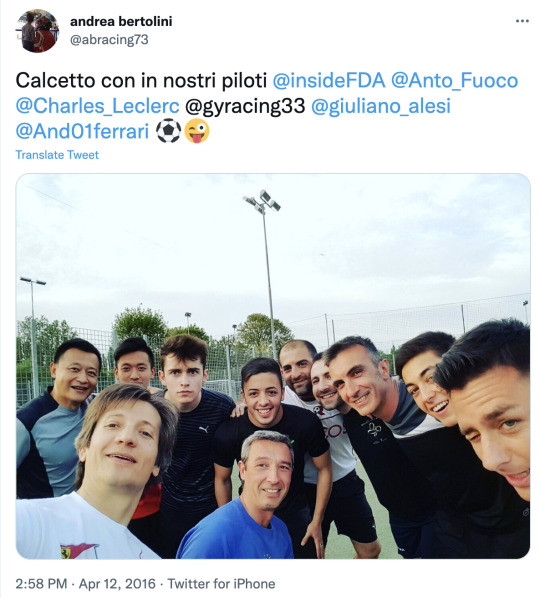
Ferrari goes a step farther by also announcing Charles as a Ferrari Development Driver and "on the books" of its F1 customer team Haas. The position with Ferrari would mean that Charles would be working on the Maranello simulators to test data for Vettel and Raikkonen, and the connection to Haas was rumored to be structured so that Charles could gain experience by driving in FP1 practices during the season.

At this point, Haas was the customer team closest to Ferrari; Sauber would not rebrand as Alfa Romero until late 2017.
Charles is the favorite going into the 2016 GP3 season, to the point where Motorsport.com titles their season preview "Can anyone stop Leclerc?":
“His karting record and early campaigns in single-seaters suggest Leclerc might be one of the biggest talents of his generation, but with that has come the burden of expectation. Still, early indications suggest he won't buckle and, if he doesn't, he might be unstoppable. [..] No wonder our entire panel picked him as the champion, Leclerc is the whole package - super fast, quick to adapt, consistent, strong racecraft. It might put too much pressure on him but not winning the title, which is as option in this field, would be a disappointment.”
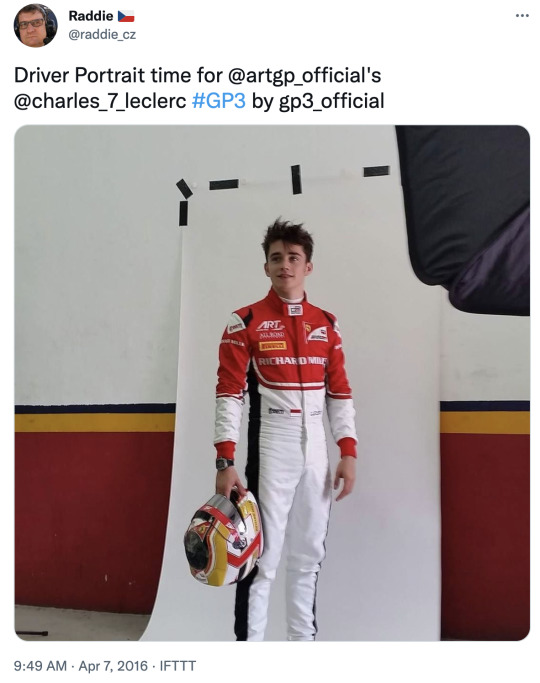
Charles starts off his GP3 career dominant. He impresses in tests by going fastest:
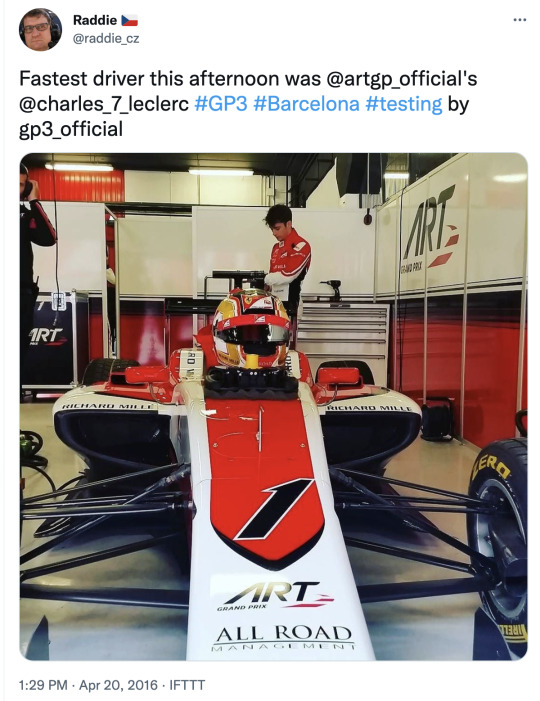
Before the GP3 season starts, Charles gets his first taste of the future by testing a F1 car for the first time.
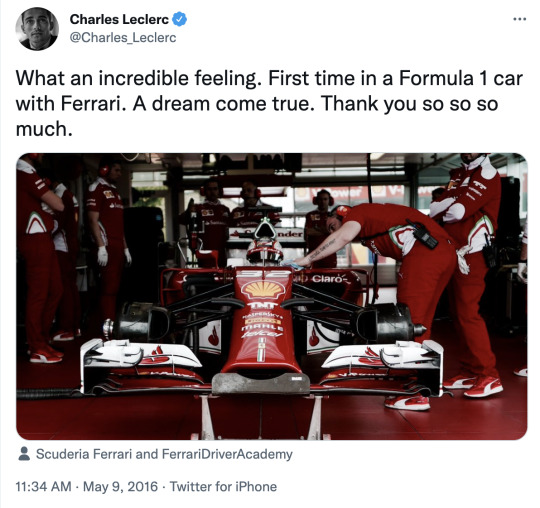
He drives a 2014-spec F14T at Fiorano with the goal of completing the 300km needed to be granted a free-practice-only super license. Charles is the first GP3 driver who tests that season.
The FIA super license is the qualification needed for a driver to compete in the F1 World Championship. In order to get a full one, a driver must (as of 2021):
Be at least 18 years old at the start of their first F1 competition
Already have an International Grade A competition license
Have a valid driving license
Pass an FIA test on the F1 sporting codes and regulations
Completed at least 80% of each of two full seasons of any of the approved single-seater Championships
Accumulated at least 40 points over the previous three seasons in those championships
Getting a full F1 super license is critical to Charles' hopes of bypassing F2 for F1 next season. He comes into this season with 17 super license points: 10 from finishing runner-up in the 2014 Formula Renault 2.0 Alps, and 7 from finishing fourth in the previous year's F3 European Championship. In GP3, 30 points are given to the winner and 20 to the runner-up; this means that anything less than first would eliminate his chance of jumping to F1 in 2017.
Charles would continue to excel through the end of the season. Unlike in F3, he would come out swinging and continue strong until the very last race. Charles wins the series opener in Barcelona; he goes from second row to leading the race by the first corner, and never looks back.
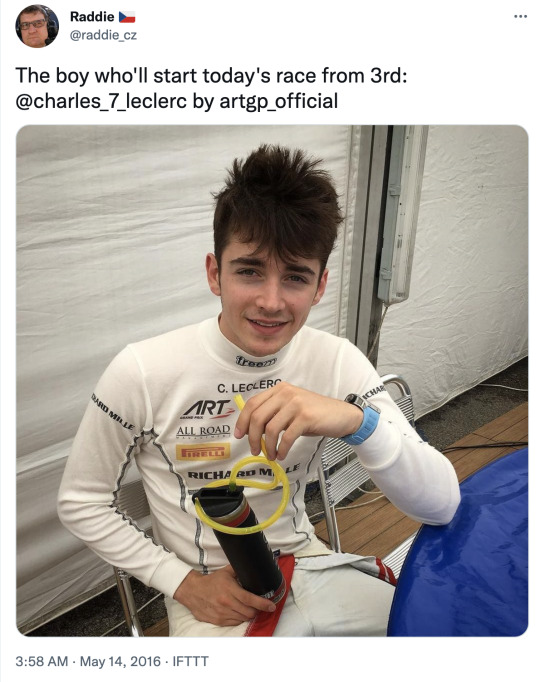


According to reports, Ferrari Team Principal Maurizio Arrivabene sneaks away to see Charles' first win as a member of his FDA.
Charles finds his only rival that season in a familiar face: Alex Albon, an old karting teammate and fellow member of the ART GP team. If you want in a more in-depth look into their relationship this season, you can read Part 2 of my Chalex primer.
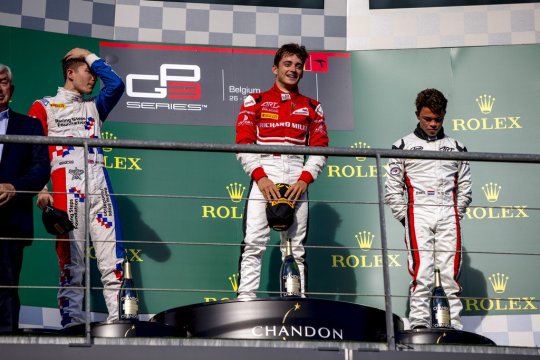
It is important to note that Alex and Charles trade wins and share multiple 1-2s throughout the season, like so:
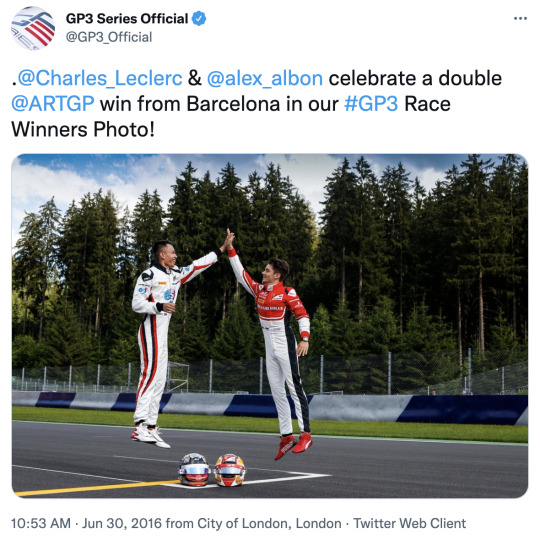
In June, Haas would officially announce Charles' first Grand Prix weekend as a test driver. He'd replace Esteban Guiterrez in five practice sessions throughout the season, starting in Silverstone.
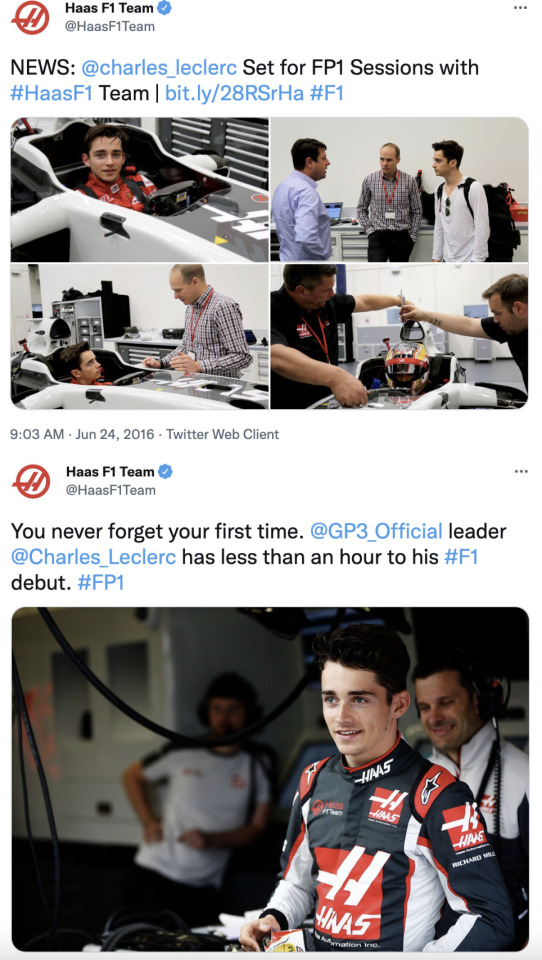
Charles does well. He says to NBC Sports:
“It’s been an amazing experience for my first time in a Formula 1 car. I was struggling quite a lot at the beginning, as Silverstone is quite a hard track with lots of high-speed corners, and I found the steering wheel quite stiff in comparison to anything I’ve driven before. However, it was a great session and lap after lap I gained confidence. The last run was on old tires, so we couldn’t show our real pace, but I think we were quite fast. We completed the program and that was the main aim, so I’m happy with that. It was probably one of the best days of my life, and to do it with Haas has been even more amazing.”
Gunther Steiner, the Haas Team Principal, agrees:
“I found it quite good how calm he was about the whole thing, and we must never forget this is an 18-year-old kid in an F1 car - the fastest racecar in the world. I wasn't surprised by him, but I was impressed by him and what he did. [...] He was very professional, he did a good job, and he showed he can do it.”

Four days later, Ferrari brings Charles back to Silverstone to test in one of their cars. He describes the difference to Autosport.com:
"It's two different things. In FP1 with Haas that was mostly for the team because they had a weekend after, and I had to work for them and do as many kilometres for them as possible. With Ferrari it was a long day so we could plan it a bit better. Unfortunately we couldn't do many laps because of a little problem on the old power unit, but both experiences have been amazing. It's still good to get experience in two different Formula 1 cars. The more cars I try, and the different ways I see of working, the more experience I get."

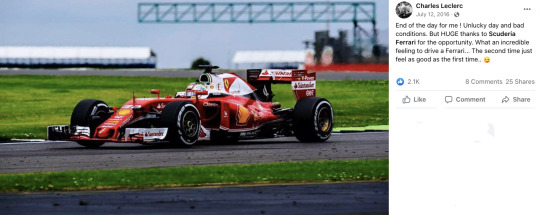
It's very clear that Jules is on Charles' mind as he tests at Ferrari. He talks extensively to the press about his mentor:
“Jules advised me really well in the past, and all his comments he gave me in the past I keep in mind and try not to make the errors he told me not to do. [...] Jules was one of the talents who would have gone [to Ferrari] if the things that happened hadn't have happened.”
Jules' memory weighs heavy on him for that entire season.
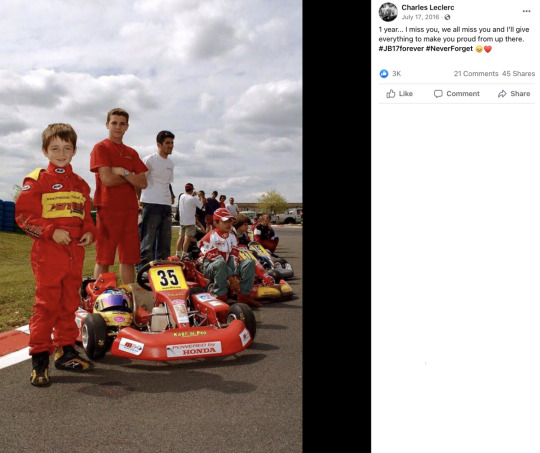

Charles continues performing at a high-level both in GP3 and as a test driver: rumors for his next season remain abundant, especially as he stays at the top of the standings. One of the largest rumors is that Charles will bypass GP2 for an F1 seat with Haas the next year.
These hopes are soon dashed. In September, Gunther announces that they will not be signing Charles for 2017. He says:
“In the position we are in, he's too inexperienced. I wouldn't say too young, as Max Verstappen does a good job. We highly respect what Leclerc is doing in FP1, he was on the gain immediately. But what we need as a team is somebody who can score points. We need to train the team, we cannot train the driver. It [taking a rookie] is not an option at the moment, it's not a thing we want to do."
The comparisons with Max continue to loom over Charles, both in F1 and GP3. An F1 junior driving ranking says in the lead up to the final race:
“In an age in which every junior driver is seemingly being measured against Max Verstappen, Leclerc is one of the few who clearly compares favorably. His Euro F3 campaign in 2015 was in my view every bit as impressive as Max Verstappen’s the year before. In 2016, Leclerc stepped up to the considerably more powerful GP3 cars and generally looked strong since winning the first race of the season. He leads the championship going into the last race weekend and most importantly leads another Ferrari junior, Antonio Fuoco, who is now in his second year of GP3. While a Formula 1 seat cannot be out of the question, I expect Ferrari will promote Leclerc to GP2 next. They may still be wary after their previous top junior, Raffaele Marciello, struggled to continue his earlier junior successes in GP2.”
The final race weekend of GP3 ends up the most important: Charles and Alex go into Abu Dhabi each with the chance of claiming the Championship.

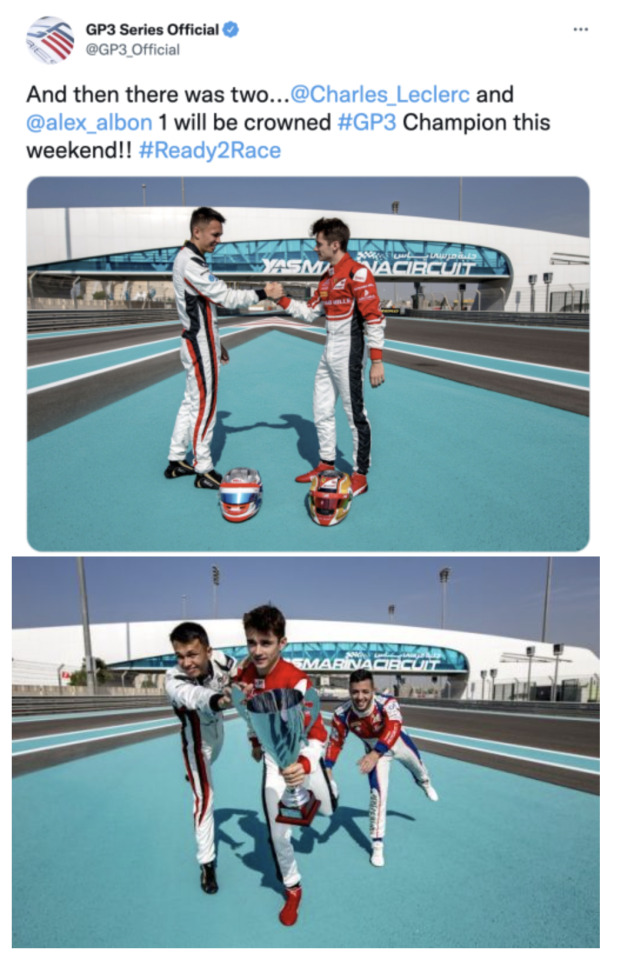
Alex says:
"I think Charles' gap is a bit big. In a way I don't have anything to lose, there is no real pressure or anything for me. It's just about doing my job doing the best that I can and let's just hope Charles has a bad weekend."
Neither of them actually finish the feature race. Alex– who had gotten pole position that weekend– hits Jack Aiken while fighting for the lead and has to retire. Charles doesn’t make it much longer in the race; he gets run off the track by Santino Ferrucci while fighting for third.
It doesn’t matter. With the way the points are, Charles wins from the sidelines.

He says:
“It was really strange to be champion and finish in the wall at the same time. When I heard on the radio we were already champions because Alex was out, then I took the risk. […] But it’s an amazing moment. So much dedication into this season - it’s amazing to finish on a high, on a low, but winning the championship.”
He also makes it clear that sometimes you can be a champion and still make time for drama:
“To be honest what Ferrucci did was completely stupid, I will have to go see him and talk to him. What he [Ferrucci] did already from the beginning of the race was really crazy, I already had problems [with him] this season and he kept going knowing I’m [competing for] a championship, which is really stupid.”
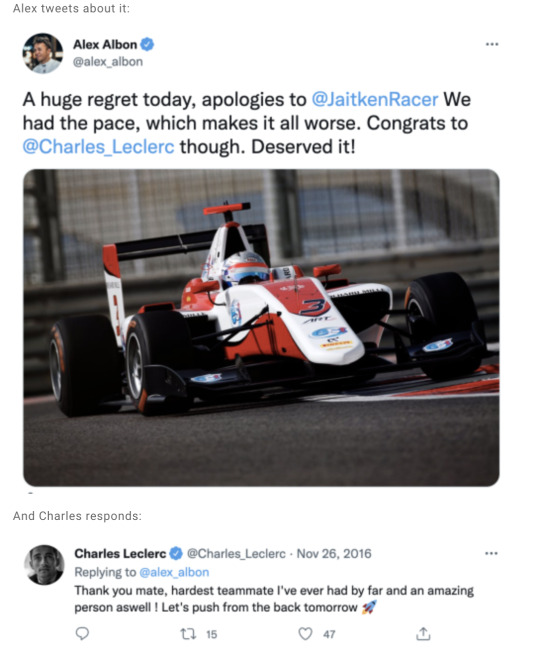
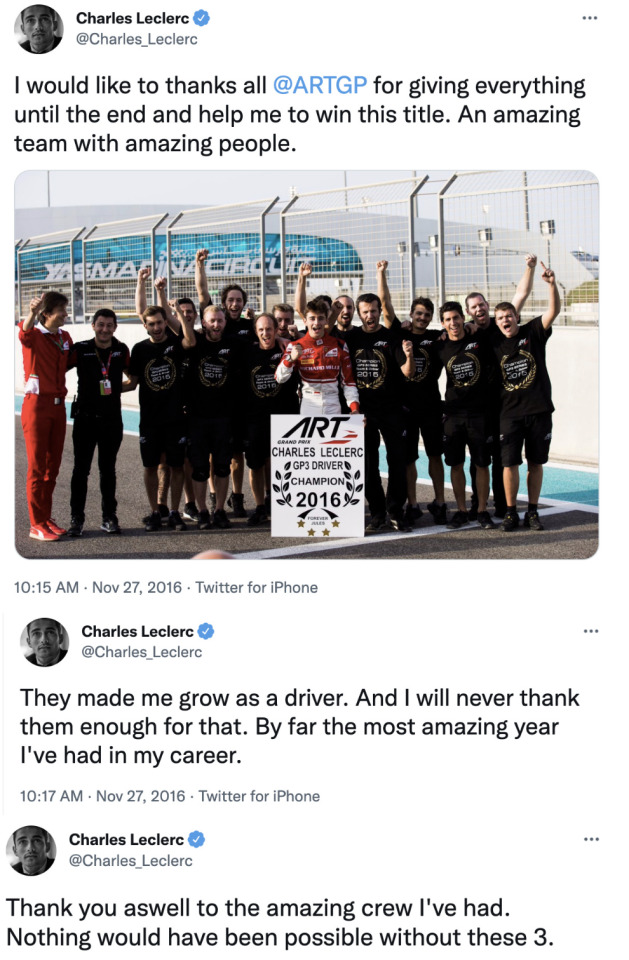
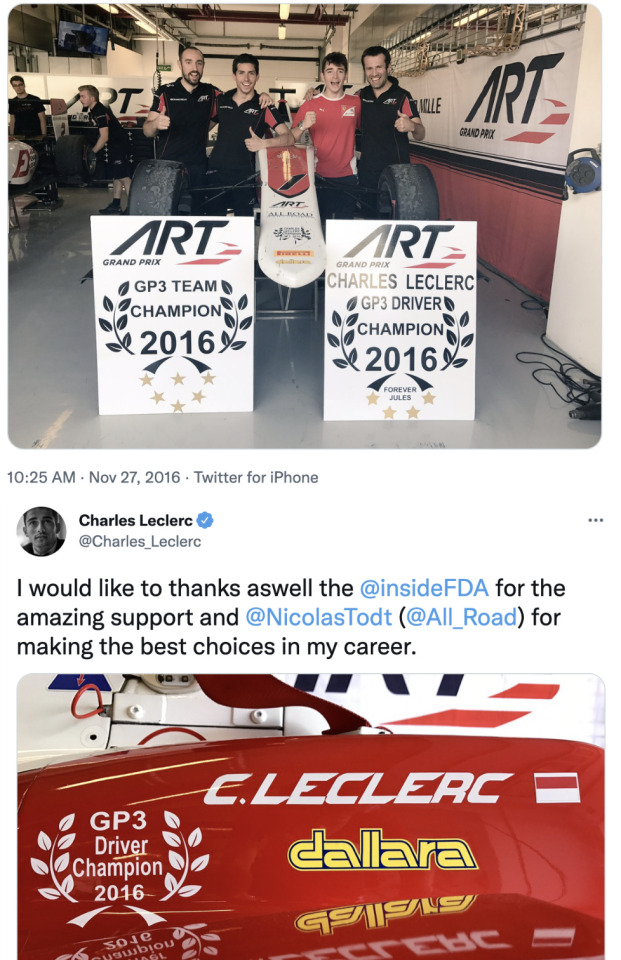
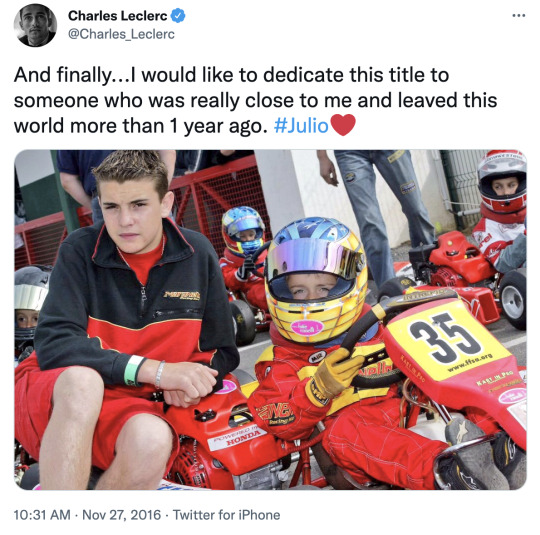
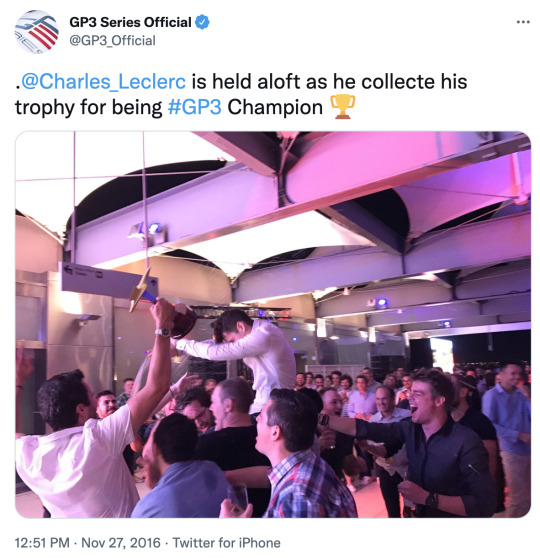
Charles finishes the season with 202 points to Alex’s 177. In December, it is announced that Charles will take Pierre’s-- who has just won GP2-- Prema spot.
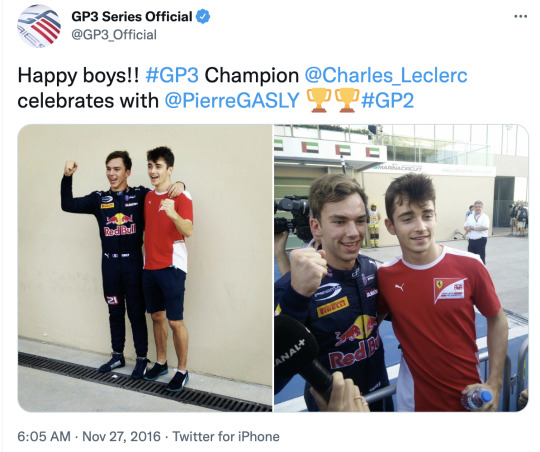

And if ART GP is good, Prema is great. It sets Charles up for another banner year.
45 notes
·
View notes
Text
What does Automation Testing software do?
Automation Testing Services
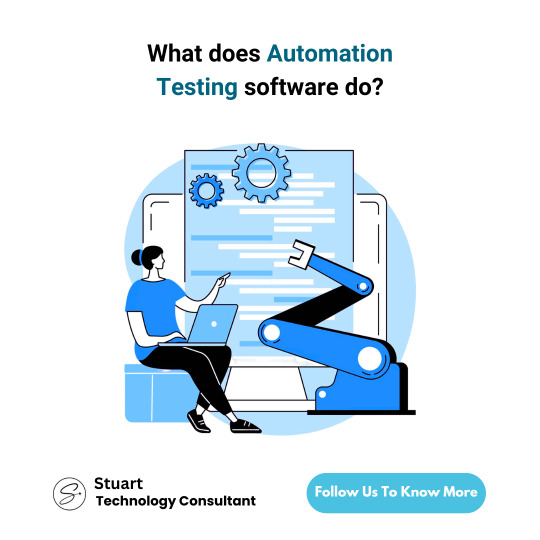
Automation Testing and its software is a tool and useful resource that helps to test applications automatically without any major considerations to look into while testing. Instead of having testers manually check every feature or function, automation tools run pre-written test scripts to check if the software works as expected. These tools can simulate user actions, test various inputs, and quickly and accurately check the software's behavior.
The main goal of automation test software is to save time, reduce human error, and increase testing coverage. It is beneficial when you must run the same tests many times, like regression testing or continuous integration setups.
Key Functions of Automation Testing Software -
Automation testing software performs several tasks that help ensure software quality. It checks if the application meets business requirements, validates data processing, tests user interfaces, and monitors performance under different conditions.
These tools can work across multiple browsers, devices, and operating systems. They help catch bugs early in the development process, reducing the cost and time needed to fix them later.
Many automation tools also integrate with other systems like CI/CD pipelines, test management platforms, and reporting dashboards—making the whole testing and development process smoother.
Benefits of Using Automation Testing Software -
Automation test software helps companies speed up testing, increase accuracy, and launch products faster. It reduces the need for repetitive manual testing, freeing testers to focus on more complex tasks.
The software runs tests 24/7 if needed, offers detailed test reports, and allows quick feedback to developers. It also supports better collaboration between QA and development teams, helping improve overall product quality.
While automation helps a lot, it doesn't fully replace manual testing. QA professionals still need to plan tests, review results, and test complex scenarios that automation can't handle, as they both are essential for the process. Automation Test is best for repetitive and everyday tasks like checking login pages, payment forms, or user dashboards and analytics. It's also helpful in regression testing — where old features must be retested after certain updates or common system upgrades.
Automation Testing software is a must-have tool and essential for modern software development operations as it gives completely transparent and reliable results if opting towards it as it saves time and the efforts of checking manually. It brings speed, reliability, and efficiency to the testing process. Trusted companies like Suma Soft, IBM, Cyntexa, and Cignex offer advanced automation testing solutions that support fast delivery, better performance, and improved software quality for businesses of all sizes.
3 notes
·
View notes
Text
Quantum computers:
leverage the principles of **quantum mechanics** (superposition, entanglement, and interference) to solve certain problems exponentially faster than classical computers. While still in early stages, they have transformative potential in multiple fields:
### **1. Cryptography & Cybersecurity**
- **Breaking Encryption**: Shor’s algorithm can factor large numbers quickly, threatening RSA and ECC encryption (forcing a shift to **post-quantum cryptography**).
- **Quantum-Safe Encryption**: Quantum Key Distribution (QKD) enables theoretically unhackable communication (e.g., BB84 protocol).
### **2. Drug Discovery & Material Science**
- **Molecular Simulation**: Modeling quantum interactions in molecules to accelerate drug design (e.g., protein folding, catalyst development).
- **New Materials**: Discovering superconductors, better batteries, or ultra-strong materials.
### **3. Optimization Problems**
- **Logistics & Supply Chains**: Solving complex routing (e.g., traveling salesman problem) for airlines, shipping, or traffic management.
- **Financial Modeling**: Portfolio optimization, risk analysis, and fraud detection.
### **4. Artificial Intelligence & Machine Learning**
- **Quantum Machine Learning (QML)**: Speeding up training for neural networks or solving complex pattern recognition tasks.
- **Faster Data Search**: Grover’s algorithm can search unsorted databases quadratically faster.
### **5. Quantum Chemistry**
- **Precision Chemistry**: Simulating chemical reactions at the quantum level for cleaner energy solutions (e.g., nitrogen fixation, carbon capture).
### **6. Climate & Weather Forecasting**
- **Climate Modeling**: Simulating atmospheric and oceanic systems with higher accuracy.
- **Energy Optimization**: Improving renewable energy grids or fusion reactor designs.
### **7. Quantum Simulations**
- **Fundamental Physics**: Testing theories in high-energy physics (e.g., quark-gluon plasma) or condensed matter systems.
### **8. Financial Services**
- **Option Pricing**: Monte Carlo simulations for derivatives pricing (quantum speedup).
- **Arbitrage Opportunities**: Detecting market inefficiencies faster.
### **9. Aerospace & Engineering**
- **Aerodynamic Design**: Optimizing aircraft shapes or rocket propulsion systems.
- **Quantum Sensors**: Ultra-precise navigation (e.g., GPS-free positioning).
### **10. Breakthroughs in Mathematics**
- **Solving Unsolved Problems**: Faster algorithms for algebraic geometry, topology, or number theory.
#future#cyberpunk aesthetic#futuristic#futuristic city#cyberpunk artist#cyberpunk city#cyberpunkart#concept artist#digital art#digital artist#quantum computers#the future of quantum computers#futuristic theory
5 notes
·
View notes
Link
2 min readPreparations for Next Moonwalk Simulations Underway (and Underwater) A digital rendering of the NASA-supported commercial space station, Vast’s Haven-1, which will provide a microgravity environment for crew, research, and in-space manufacturing.Vast NASA-supported commercial space station, Vast’s Haven-1, recently completed a test of a critical air filter system for keeping future astronauts healthy in orbit. Testing confirmed the system can maintain a safe and healthy atmosphere for all planned Haven-1 mission phases. Testing of the trace contaminant control system was completed at NASA’s Marshall Space Flight Center in Huntsville, Alabama, as part of a reimbursable Space Act Agreement. Vast also holds an unfunded Space Act Agreement with NASA as part of the second Collaborations for Commercial Space Capabilities initiative. Adrian Johnson, air chemist at NASA’s Marshall Space Flight Center in Huntsville, Alabama, operates the Micro-GC, which is used to measure carbon monoxide levels, during a trace contaminant control system test in the environmental chamber.NASA The subsystem of the environmental control and life support system is comprised of various filters designed to scrub hazardous chemicals produced by both humans and materials on the commercial station. During the test, a representative chemical environment was injected into a sealed environmental chamber, and the filtration system was turned on to verify the trace contaminant control system could maintain a healthy atmosphere. “Testing of environmental control systems and subsystems is critical to ensure the health and safety of future commercial space station crews,” said Angela Hart, program manager for NASA’s Commercial Low Earth Orbit Development Program at the agency’s Johnson Space Center in Houston. “Through NASA’s agreements with Vast and our other industry partners, the agency is contributing technical expertise, technologies, services, and facilities to support companies in the development of commercial stations while providing NASA important insight into the development and readiness to support future agency needs and services in low Earth orbit.” NASA-supported commercial space station, Vast’s Haven-1, trace contaminant control filters and support hardware pictured within the environmental chamber at the agency’s Marshall Space Flight Center, Huntsville, Alabama.NASA Experts used the same environmental chamber at Marshall to test the International Space Station environmental control and life support system. The knowledge and data gained during the recent testing will help validate Vast’s Haven-1 and support future Haven-2 development. NASA supports the design and development of multiple commercial space stations through funded and unfunded agreements. NASA plans to procure services from one or more companies following the design and development phase as part of the agency’s strategy to become one of many customers for low Earth orbit stations. For more information about commercial space stations, visit: www.nasa.gov/commercialspacestations Keep Exploring Discover More Topics Commercial Space Stations in Low Earth Orbit NASA is supporting the development of commercially owned and operated space stations in low Earth orbit from which the agency,… Low Earth Orbit Economy Commercial Crew Program NASA’s Low Earth Orbit Microgravity Strategy
2 notes
·
View notes
Text
Driven by Desire: Fire and Speed - 16. New Era
The Unstoppable Series - Masterlist

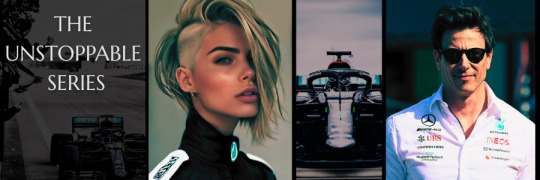
Four parts. Two hearts. One love story.
pairing: Toto Wolff x Miriell Joschke (Original Character, female F1 driver)
Series warnings: long fan fiction/series, slow burn (long), age gap (23 years), woman racing in F1, boss/driver relationship, difficult and painful past, death, angst, recovery after trauma and loss, love after loss, sexual tension, sex scenes, illness, pregnancy, memory lost.
full series word count: 218k words of speed, scars, slow-burning love, and everything in between.
----------------
chapters until now of Part 4: Driven by Desire: Fire and Speed
Prologue
Return to Life
YES!
We are back
Third World Championship Title
The Night That Changed Everything
The Inevitable Conversation
Now and Forever [18+]
You Are the Reason
Our Place
The New Driver
Night Experiments [18+]
In His Power [18+]
Memories
The Royal Couple of F1 [18+]
New Era
The First Race of the Season and Rumors
Mercedes – Power, Style, and Authority
Triumph of a Young Champion
Shadows of the Night
The Sea, the Silence, Us [18+]
previous Parts:
Part 1: Driven by Speed - A Diamond Among Stones
Part 2: Driven by Success - Golden Girl
Part 3: Driven by Love - Rebirth from the Ashes
-----------------------------

16. New Era
The Launch
Brackley, February, car launch
POV Toto
This day was always special. The launch of a new car wasn't just the culmination of months of hard work—it was the first step into a new season. A new fight. A new story.
We stood on stage, the spotlights reflecting off the polished bodywork. At the center stood the result of hundreds of people's dedication—our new car. Perfectly refined, flawless in every detail, packed with innovations designed to give us the edge.
To my left stood Miriell. She wore the official race suit, yet still managed to look like a star. Her eyes sparkled as she looked at the machine she would drive to more victories. Beside her was Kimi, a little shy but smiling wide, clearly eager to get behind the wheel.
To my right was James Allison, the engineering mastermind without whom this car wouldn't exist.
Cameras were everywhere, the launch streamed live, journalists packed into the front rows, ready to dissect our every move. But in that moment, all I cared about was the feeling—that we were ready to fight again.
When the curtain dropped, revealing the car in all its glory, the room filled with applause.
Miriell glanced at me and smiled.
"It looks even better than in the simulations."
I chuckled softly.
"And it's going to be even faster on track."
James nodded.
"If the simulations are right, we've got a beast on our hands."
Kimi grinned wider.
"Can't wait for testing in Bahrain."
I began speaking to the gathered media, talking about the technical innovations, the incredible work of our team—but the real magic happened when I handed the mic over to Miriell.
"I can't wait to take it out on track," she said, her voice confident, the spark in her eyes unmistakable. "I know everyone here gave their all to create this machine, and I can promise you one thing—I'll do everything I can to make it the fastest."
I was proud. The whole team was proud.
After the official part ended and journalists began asking questions, I watched Miriell from the side. She didn't need to say a word—I could feel what she was feeling.
Excitement. Readiness. The hunger to fight.
And I felt it too.
The new season had just begun.
Pre-Season Testing
Bahrain, February
POV Toto
Pre-season testing had always been intense. It was the moment we first put our car to the test under real conditions, comparing data, analyzing pace, and looking for any edge over the competition. But this year, the pressure felt even greater. Not because of the machine. Not because of the strategy.
Because of us.
It was the first time Miriell and I showed up in the paddock as a married couple, and the media seemed more thrilled about that than anything happening on track. Wherever we went—cameras, flashes, questions.
"How is it working together as a married couple?"
"Does it change the team dynamic?"
"Won't your personal life affect professionalism?"
Every time, I gave the same answer:
"Nothing changes. We're professionals. The same rules still apply."
Still, I saw the smirks, the sidelong glances. Everyone was waiting for something to prove that something had changed.
But we didn't give them that satisfaction.
Miriell was in her element. She focused on driving, on providing feedback to the engineers, on refining every detail. She was fast, precise, focused—just as she had always been.
Kimi, the eager 18-year-old, was clearly excited and hungry to learn. Miriell happily explained everything to him, sharing her experience generously.
After the morning session, I had the usual team principals' meeting—standard procedure: regulation updates, reporting issues, minor complaints. As I left the room, I sensed someone quickly approaching.
Christian Horner.
Of course.
"Well, well, if it isn't the man who won not just the championship, but also his driver's heart," he said with that familiar smug amusement. "The real question is—can you keep up?"
I crossed my arms and gave him a calm, expectant smile.
"I don't know, Christian. Enlighten me. Keep up with what, exactly?"
Horner raised his eyebrows like he was feigning surprise—but he knew exactly what he was implying.
"With your young, energetic world champion. Let's be honest, Toto—you're pushing fifty. Maybe it's time to consider something a bit more... relaxed? Don't you worry your heart might just give out from all the excitement?"
I smirked. Ah, Christian. He wouldn't be himself if he didn't try to get a jab in.
"Thanks for the concern, but my heart's doing just fine. In fact, ever since I've been with Miriell, I feel younger than ever."
He let out a short laugh.
"Oh really? So it's more effective than your little operation last year?"
I chuckled, shaking my head.
"You see, Christian, the difference between us is that you're still trying to prove your worth with results on the track. I haven't needed to prove anything for a long time—neither there, nor in the bedroom."
Bullseye.
For a split second, he tensed—but then quickly recovered his usual smirk.
"Well, congratulations then. Let's just hope your star doesn't burn out too fast. You know how quickly young talents get bored..."
I took a step closer and met his eyes.
"Or maybe you just haven't met a woman who actually wants to stay."
He was silent for a moment, then laughed and waved a hand as he turned to walk away.
"Always witty, Toto. Well, we'll see who's laughing after the first race."
I stood there for a second, watching him leave, then sighed and turned toward the garage.
There was work to do.
And honestly, I couldn't wait to show them all—again—why we run this sport.
-------------------
NEXT -> 17. The First Race of the Season and Rumors
-------------------
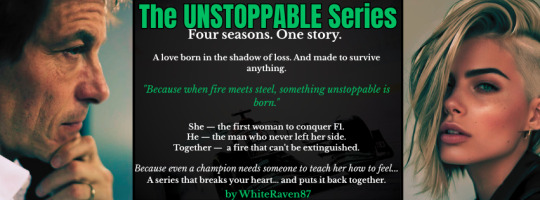
"I put my armor on, show you how strong I am."
Read the story here:
AO3 Unstoppable Series
Wattpad: Part1 I Part 2 I Part 3 | Part 4
🇵🇱 Dla Polskich czytelników [for Polish readers] [PL]:
Seria Niepowstrzymana AO3
Wattpad PL: Part1 I Part 2 I Part 3 | Part 4
#toto wolff#f1 fic#f1 x oc#toto wolff fluff#kimi antonelli#andrea kimi antonelli#toto wolff imagine#toto wolff x oc#toto wolff fanfiction#toto wolff fanfic#toto wolff ff#f1 fanfiction#f1 imagine#f1#formula 1 fanfiction#formula 1 fanfic#formula one fanfiction#f1 fluff#f1 x female driver#f1 x female oc#toto wolff x female oc#f1 fanfic#ao3 fanfic#ao3#wattpad#formula 1 imagine#mercedes f1#formula one x oc#formula 1 x oc#f1 fics
5 notes
·
View notes
Text
Why do cross-border e-commerce companies need to use fingerprint browsers to carry out their work?
Protect privacy and security: Cross-border e-commerce involves sensitive data such as users 'personal information and transaction information, which is easily obtained by attackers such as hackers and malicious websites. Fingerprint browsers can hide users 'real fingerprint information and prevent data from being traced or identified, thereby protecting users' privacy and security.
Prevent account association: Cross-border e-commerce platforms usually detect users 'device fingerprint information to determine whether accounts are associated. If you use an ordinary browser, the fingerprint information between different accounts may be the same and can easily be detected by the platform, thereby restricting or blocking accounts. Using a fingerprint browser can modify or disguise fingerprint information, giving each account a unique browser environment, thereby preventing account association
Multi-account management: Cross-border e-commerce merchants usually have multiple store accounts to increase product exposure and seize the front page of product pages. Using an ordinary browser to manage multiple accounts will lead to the same fingerprint information and be easily detected by the platform. Using a fingerprint browser can create a separate browser environment for each account, making it convenient for merchants to manage multiple accounts.
Improve work efficiency: Use a fingerprint browser to log in to multiple accounts at the same time for batch operations and management to improve work efficiency. In addition, fingerprint browsers can also simulate different user agents, operating systems, browser plug-ins, language settings, screen resolutions and other characteristics, making it convenient for merchants to test and optimize websites.
2 notes
·
View notes
Text
Why are LED headlights more visible than classic headlights under sunlight?
LED headlights are more conspicuous in sunlight than traditional halogen or xenon headlights, mainly due to the following scientific principles and design advantages:
High color temperature matches the sunlight spectrum
Color temperature characteristics:
The color temperature of LEDs is usually 5000K-6500K (cold white light), close to midday sunlight (5500K), and has a high overlap with the natural light spectrum. Traditional halogen lamps have a lower color temperature (3000K-3500K, yellowish), and are easily drowned out by ambient light in sunlight.
Human eye sensitivity:
The human eye is most sensitive to 555nm wavelength (yellow-green light), but in sunlight, high color temperature blue-white light (450-500nm) is more easily perceived because it forms a higher contrast with the sky background (Weber-Fechner law).
Ultra-high brightness and luminous efficiency
Luminous flux density:
The brightness of a single LED lamp bead can reach 200-300 lumens/watt (halogen lamps are only 20-30 lumens/watt), and the light intensity per unit area (candela/square meter) is 3-5 times higher. For example, the total luminous flux of a certain LED headlight is about 4000 lumens, while the halogen lamp is only 1500 lumens.
Light saturation resistance:
The ground illumination under direct sunlight is about 100,000 lux. Through the focusing design, the local light intensity of LED can reach 20,000 candela (cd), while the halogen lamp is only about 8000cd. The former is easier to break through the interference of ambient light.
Precise beam control technology
Microlens array (MLA):
The LED chip integrates thousands of micron-level lenses to focus the light into a parallel beam with a divergence angle of 0.1°, reducing scattering losses.
Active matrix control:
For example, Audi's Matrix LED system dynamically enhances the brightness of specific areas (such as road sign reflection areas) under strong light by independently controlling 64 LED units.
Spectrum optimization and penetration
Blue light excitation phosphor:
LED excites YAG phosphor with 450nm blue light to emit broad-spectrum white light. Its short-wavelength component (blue-violet light) is easier to penetrate haze under Rayleigh scattering, improving long-distance recognition rate under sunlight.
Color rendering index (CRI):
LED's CRI>80 (halogen lamp CRI≈100). Although the color rendering is slightly inferior, the high CRI reduces the contrast under strong light. The "unnatural light" characteristics of LED unexpectedly enhance recognition.
Dynamic response and flicker suppression
Nanosecond response:
LED turn-on time <100ns, when the vehicle is bumpy or the sun is flickering, it can maintain stable light output. Traditional filament bulbs have a thermal inertia of 100-200ms, which is prone to residual visual blur.
PWM dimming technology:
Through 1000Hz high-frequency pulse width modulation, while maintaining brightness, the human eye can avoid stroboscopic perception and enhance dynamic visual capture capabilities.
Thermal management advantages
Low temperature operation:
The LED junction temperature is controlled below 85°C (halogen filament reaches 2500°C) to avoid light decay caused by high temperature. Under the scorching sun, the LED brightness decays by only 3%/1000 hours, while the halogen lamp decays by 15%/1000 hours under the same conditions.
Empirical data
Contrast test (ISO 16505 standard):
Under 100,000 lux simulated daylight, the recognition rate of LED headlights at 100 meters is 92%, while that of halogen lamps is only 68%.
Accident rate statistics (NHTSA report):
Vehicles equipped with LED daytime running lights have a 24% reduction in the rate of multi-vehicle collision accidents during the day, while traditional lighting groups only reduce it by 8%.
Conclusion LEDs break through the background noise of sunlight through high color temperature spectrum matching, ultra-high light efficiency, precise optical design and dynamic response, achieving an "optical breakthrough". This advantage not only improves safety, but also promotes the evolution of automotive lighting towards intelligent light field control.

#led lights#car lights#led car light#youtube#led auto light#led headlights#led light#led headlight bulbs#ledlighting#young artist#laser headlights#headlight bulb#headlamp#headlight#american cars#classic cars#cars#car culture#car#car lamp#car light#suv#vehicle#automobile#lamp#halogen#poultryfarming
2 notes
·
View notes
Text
How Technology Is Changing the Driver’s License Process in Canada: 2025 Update

In the ever-evolving world of technology, the process of obtaining a driver's license in Canada is undergoing significant transformation. From online study tools to AI-assisted road tests, advancements in technology are reshaping how new drivers prepare for, take, and even manage their driver’s licenses. Whether you're a new resident, a teenager, or an experienced driver upgrading your license, understanding these technological changes is crucial. This blog explores the key developments in the licensing process and how technology is making it easier, more efficient, and even safer to get your driver’s license in 2025.
1. Online Study Tools and Test Preparation
One of the most notable changes in the licensing process in Canada is the availability of online study resources. In 2025, many provinces have embraced digital tools to help drivers prepare for the written knowledge test. Websites like licenseprep.ca provide online practice tests, detailed study guides, and interactive content that covers everything from road signs to traffic laws.
Gone are the days when you had to rely solely on paper handbooks. With the convenience of online platforms, you can access study materials anytime, anywhere. These resources often feature real-time feedback, allowing you to track your progress and pinpoint areas that need improvement. The digital approach not only makes studying more flexible but also ensures that you are up to date with the latest traffic laws and regulations.
2. Digital Driver’s License (eDL)
In several Canadian provinces, the digital driver’s license (eDL) has become a reality. Ontario and British Columbia have already rolled out this innovative service, where drivers can access their license through a mobile app. The eDL allows users to store a digital version of their license securely on their smartphones.
The eDL is accepted as an official form of ID and can be used for everything from purchasing alcohol to showing your license to law enforcement. In the future, we can expect more provinces to adopt this technology, providing greater convenience and security for Canadian drivers. This shift also reduces the risk of losing your physical card and eliminates the need to carry a bulky wallet.
3. AI-Assisted Road Tests
Artificial Intelligence (AI) is starting to play a role in Canada’s road test evaluations. AI-assisted driving tests are being piloted in some provinces, where in-car sensors and cameras track your performance during the road test. These systems can monitor things like your speed, lane positioning, and the quality of your braking, providing examiners with objective data to supplement their judgment.
While AI is not yet fully replacing human examiners, it’s enhancing the overall assessment process. By using AI, the road test becomes more precise, ensuring that every driver is evaluated fairly based on their skills and abilities. In the long term, AI-assisted evaluations could help reduce human error and improve safety on the road.
4. Virtual Reality (VR) Driving Simulators
In an effort to improve driving education, some driving schools are now incorporating virtual reality (VR) simulators into their training programs. These simulators replicate real-world driving scenarios, allowing students to practice their skills in a controlled environment before getting behind the wheel. They can practice everything from parallel parking to handling adverse weather conditions without the risk.
While VR training isn’t mandatory, it offers valuable benefits, particularly for new drivers who are nervous or lack experience in specific driving situations. It’s a safe and effective way to build confidence and become comfortable with a variety of driving scenarios that might be hard to replicate in a regular driving school setting.
5. Online Knowledge Tests and Faster Licensing
In some provinces, you can now take the written knowledge test online. This is especially beneficial for people who might not have access to a local service center or who prefer the convenience of studying and testing from home. By offering online tests, provinces can reduce wait times and make the licensing process more accessible.
Moreover, some provinces are streamlining the process of upgrading your license. For example, in Ontario, the G1 license can now be upgraded to G2 after only 8 months if you complete an accredited driver education program. This shorter waiting period allows new drivers to gain more experience on the road and work towards their full G license faster.
6. Automated and Digital Driver’s Education
Canada’s driver education programs have also adapted to technology by offering more automated and digital learning options. Many driving schools now provide online courses that allow students to complete theoretical lessons at their own pace. These programs often include interactive quizzes, video tutorials, and real-world simulations to help students learn road safety and driving laws.
The convenience of online driver’s education has made it easier for people with busy schedules to complete their courses. These programs also enable instructors to track students' progress digitally, ensuring that they have mastered the required knowledge before moving on to practical training.
7. The Future of Driver’s Licenses in Canada
Looking ahead, it’s clear that technology will continue to play a significant role in shaping the future of driving in Canada. From autonomous vehicles to smart roads that communicate with cars, the world of driving is rapidly changing. The driver’s license process will likely evolve to accommodate these new technologies, and we may see more digital tools, AI-driven tests, and even the introduction of self-driving car licenses in the future.
Additionally, with climate change being a key focus of Canadian policy, future licenses may also include environmental considerations. For instance, drivers could be required to take courses on eco-friendly driving techniques, or there may be new policies that encourage the adoption of electric vehicles.
Navigating the 2025 Driver’s License Process:
Stay Up-to-Date: Technology is advancing rapidly, so keep an eye on new developments related to licensing procedures in your province.
Leverage Online Resources: Use online study tools like licenseprep.ca to ensure you’re prepared for both written and practical tests.
Consider Driver Education Programs: While online learning is helpful, consider enrolling in a driving school for hands-on experience and confidence-building.
Get Comfortable with Digital Licensing: Learn about the digital driver’s license option in your province for added convenience and security.
Prepare for the Future: Be ready for possible changes in driver’s licensing laws, especially as autonomous vehicles and green technologies become more integrated into Canadian roads.
Learn the Rules with licenseprep.ca Driving laws may differ from what you're used to. Use licenseprep.ca to study road signs, local rules, and prepare for your tests confidently.
#CanadasDriversLicense#2025DrivingLaws#TechnologyInDriving#DigitalDriversLicense#AIAssistedDrivingTests#DriverEducationCanada#licenseprep#VirtualDrivingSimulators#DrivingInCanada#SmartDriverLicense
2 notes
·
View notes
Text
How will AI be used in health care settings?
Artificial intelligence (AI) shows tremendous promise for applications in health care. Tools such as machine learning algorithms, artificial neural networks, and generative AI (e.g., Large Language Models) have the potential to aid with tasks such as diagnosis, treatment planning, and resource management. Advocates have suggested that these tools could benefit large numbers of people by increasing access to health care services (especially for populations that are currently underserved), reducing costs, and improving quality of care.
This enthusiasm has driven the burgeoning development and trial application of AI in health care by some of the largest players in the tech industry. To give just two examples, Google Research has been rapidly testing and improving upon its “Med-PaLM” tool, and NVIDIA recently announced a partnership with Hippocratic AI that aims to deploy virtual health care assistants for a variety of tasks to address a current shortfall in the supply in the workforce.
What are some challenges or potential negative consequences to using AI in health care?
Technology adoption can happen rapidly, exponentially going from prototypes used by a small number of researchers to products affecting the lives of millions or even billions of people. Given the significant impact health care system changes could have on Americans’ health as well as on the U.S. economy, it is essential to preemptively identify potential pitfalls before scaleup takes place and carefully consider policy actions that can address them.
One area of concern arises from the recognition that the ultimate impact of AI on health outcomes will be shaped not only by the sophistication of the technological tools themselves but also by external “human factors.” Broadly speaking, human factors could blunt the positive impacts of AI tools in health care—or even introduce unintended, negative consequences—in two ways:
If developers train AI tools with data that don’t sufficiently mirror diversity in the populations in which they will be deployed. Even tools that are effective in the aggregate could create disparate outcomes. For example, if the datasets used to train AI have gaps, they can cause AI to provide responses that are lower quality for some users and situations. This might lead to the tool systematically providing less accurate recommendations for some groups of users or experiencing “catastrophic failures” more frequently for some groups, such as failure to identify symptoms in time for effective treatment or even recommending courses of treatment that could result in harm.
If patterns of AI use systematically differ across groups. There may be an initial skepticism among many potential users to trust AI for consequential decisions that affect their health. Attitudes may differ within the population based on attributes such as age and familiarity with technology, which could affect who uses AI tools, understands and interprets the AI’s output, and adheres to treatment recommendations. Further, people’s impressions of AI health care tools will be shaped over time based on their own experiences and what they learn from others.
In recent research, we used simulation modeling to study a large range of different of hypothetical populations of users and AI health care tool specifications. We found that social conditions such as initial attitudes toward AI tools within a population and how people change their attitudes over time can potentially:
Lead to a modestly accurate AI tool having a negative impact on population health. This can occur because people’s experiences with an AI tool may be filtered through their expectations and then shared with others. For example, if an AI tool’s capabilities are objectively positive—in expectation, the AI won’t give recommendations that are harmful or completely ineffective—but sufficiently lower than expectations, users who are disappointed will lose trust in the tool. This could make them less likely to seek future treatment or adhere to recommendations if they do and lead them to pass along negative perceptions of the tool to friends, family, and others with whom they interact.
Create health disparities even after the introduction of a high-performing and unbiased AI tool (i.e., that performs equally well for all users). Specifically, when there are initial differences between groups within the population in their trust of AI-based health care—for example because of one group’s systematically negative previous experiences with health care or due to the AI tool being poorly communicated to one group—differential use patterns alone can translate into meaningful differences in health patterns across groups. These use patterns can also exacerbate differential effects on health across groups when AI training deficiencies cause a tool to provide better quality recommendations for some users than others.
Barriers to positive health impacts associated with systematic and shifting use patterns are largely beyond individual developers’ direct control but can be overcome with strategically designed policies and practices.
What could a regulatory framework for AI in health care look like?
Disregarding how human factors intersect with AI-powered health care tools can create outcomes that are costly in terms of life, health, and resources. There is also the potential that without careful oversight and forethought, AI tools can maintain or exacerbate existing health disparities or even introduce new ones. Guarding against negative consequences will require specific policies and ongoing, coordinated action that goes beyond the usual scope of individual product development. Based on our research, we suggest that any regulatory framework for AI in health care should accomplish three aims:
Ensure that AI tools are rigorously tested before they are made fully available to the public and are subject to regular scrutiny afterward. Those developing AI tools for use in health care should carefully consider whether the training data are matched to the tasks that the tools will perform and representative of the full population of eventual users. Characteristics of users to consider include (but are certainly not limited to) age, gender, culture, ethnicity, socioeconomic status, education, and language fluency. Policies should encourage and support developers in investing time and resources into pre- and post-launch assessments, including:
pilot tests to assess performance across a wide variety of groups that might experience disparate impact before large-scale application
monitoring whether and to what extent disparate use patterns and outcomes are observed after release
identifying appropriate corrective action if issues are found.
Require that users be clearly informed about what tools can do and what they cannot. Neither health care workers nor patients are likely to have extensive training or sophisticated understanding of the technical underpinnings of AI tools. It will be essential that plain-language use instructions, cautionary warnings, or other features designed to inform appropriate application boundaries are built into tools. Without these features, users’ expectations of AI capabilities might be inaccurate, with negative effects on health outcomes. For example, a recent report outlines how overreliance on AI tools by inexperienced mushroom foragers has led to cases of poisoning; it is easy to imagine how this might be a harbinger of patients misdiagnosing themselves with health care tools that are made publicly available and missing critical treatment or advocating for treatment that is contraindicated. Similarly, tools used by health care professionals should be supported by rigorous use protocols. Although advanced tools will likely provide accurate guidance an overwhelming majority of the time, they can also experience catastrophic failures (such as those referred to as “hallucinations” in the AI field), so it is critical for trained human users to be in the loop when making key decisions.
Proactively protect against medical misinformation. False or misleading claims about health and health care—whether the result of ignorance or malicious intent—have proliferated in digital spaces and become harder for the average person to distinguish from reliable information. This type of misinformation about health care AI tools presents a serious threat, potentially leading to mistrust or misapplication of these tools. To discourage misinformation, guardrails should be put in place to ensure consistent transparency about what data are used and how that continuous verification of training data accuracy takes place.
How can regulation of AI in health care keep pace with rapidly changing conditions?
In addition to developers of tools themselves, there are important opportunities for unaffiliated researchers to study the impact of AI health care tools as they are introduced and recommend adjustments to any regulatory framework. Two examples of what this work might contribute are:
Social scientists can learn more about how people think about and engage with AI tools, as well as how perceptions and behaviors change over time. Rigorous data collection and qualitative and quantitative analyses can shed light on these questions, improving understanding of how individuals, communities, and society adapt to shifts in the health care landscape.
Systems scientists can consider the co-evolution of AI tools and human behavior over time. Building on or tangential to recent research, systems science can be used to explore the complex interactions that determine how multiple health care AI tools deployed across diverse settings might affect long-term health trends. Using longitudinal data collected as AI tools come into widespread use, prospective simulation models can provide timely guidance on how policies might need to be course corrected.
6 notes
·
View notes
Text
Smart Switchgear in 2025: What Electrical Engineers Need to Know

In the fast-evolving world of electrical infrastructure, smart switchgear is no longer a futuristic concept — it’s the new standard. As we move through 2025, the integration of intelligent systems into traditional switchgear is redefining how engineers design, monitor, and maintain power distribution networks.
This shift is particularly crucial for electrical engineers, who are at the heart of innovation in sectors like manufacturing, utilities, data centers, commercial construction, and renewable energy.
In this article, we’ll break down what smart switchgear means in 2025, the technologies behind it, its benefits, and what every electrical engineer should keep in mind.
What is Smart Switchgear?
Smart switchgear refers to traditional switchgear (devices used for controlling, protecting, and isolating electrical equipment) enhanced with digital technologies, sensors, and communication modules that allow:
Real-time monitoring
Predictive maintenance
Remote operation and control
Data-driven diagnostics and performance analytics
This transformation is powered by IoT (Internet of Things), AI, cloud computing, and edge devices, which work together to improve reliability, safety, and efficiency in electrical networks.
Key Innovations in Smart Switchgear (2025 Edition)
1. IoT Integration
Smart switchgear is equipped with intelligent sensors that collect data on temperature, current, voltage, humidity, and insulation. These sensors communicate wirelessly with central systems to provide real-time status and alerts.
2. AI-Based Predictive Maintenance
Instead of traditional scheduled inspections, AI algorithms can now predict component failure based on usage trends and environmental data. This helps avoid downtime and reduces maintenance costs.
3. Cloud Connectivity
Cloud platforms allow engineers to remotely access switchgear data from any location. With user-friendly dashboards, they can visualize key metrics, monitor health conditions, and set thresholds for automated alerts.
4. Cybersecurity Enhancements
As devices get connected to networks, cybersecurity becomes crucial. In 2025, smart switchgear is embedded with secure communication protocols, access control layers, and encrypted data streams to prevent unauthorized access.
5. Digital Twin Technology
Some manufacturers now offer a digital twin of the switchgear — a virtual replica that updates in real-time. Engineers can simulate fault conditions, test load responses, and plan future expansions without touching the physical system.
Benefits for Electrical Engineers
1. Operational Efficiency
Smart switchgear reduces manual inspections and allows remote diagnostics, leading to faster response times and reduced human error.
2. Enhanced Safety
Early detection of overload, arc flash risks, or abnormal temperatures enhances on-site safety, especially in high-voltage environments.
3. Data-Driven Decisions
Real-time analytics help engineers understand load patterns and optimize distribution for efficiency and cost savings.
4. Seamless Scalability
Modular smart systems allow for quick expansion of power infrastructure, particularly useful in growing industrial or smart city projects.
Applications Across Industries
Manufacturing Plants — Monitor energy use per production line
Data Centers — Ensure uninterrupted uptime and cooling load balance
Commercial Buildings — Integrate with BMS (Building Management Systems)
Renewable Energy Projects — Balance grid load from solar or wind sources
Oil & Gas Facilities — Improve safety and compliance through monitoring
What Engineers Need to Know Moving Forward
1. Stay Updated with IEC & IEEE Standards
Smart switchgear must comply with global standards. Engineers need to be familiar with updates related to IEC 62271, IEC 61850, and IEEE C37 series.
2. Learn Communication Protocols
Proficiency in Modbus, DNP3, IEC 61850, and OPC UA is essential to integrating and troubleshooting intelligent systems.
3. Understand Lifecycle Costing
Smart switchgear might have a higher upfront cost but offers significant savings in maintenance, energy efficiency, and downtime over its lifespan.
4. Collaborate with IT Teams
The line between electrical and IT is blurring. Engineers should work closely with cybersecurity and cloud teams for seamless, secure integration.
Conclusion
Smart switchgear is reshaping the way electrical systems are built and managed in 2025. For electrical engineers, embracing this innovation isn’t just an option — it’s a career necessity.
At Blitz Bahrain, we specialize in providing cutting-edge switchgear solutions built for the smart, digital future. Whether you’re an engineer designing the next big project or a facility manager looking to upgrade existing systems, we’re here to power your progress.
#switchgear#panel#manufacturer#bahrain25#electrical supplies#electrical equipment#electrical engineers#electrical
6 notes
·
View notes
Text
The Complete NEET PG Counseling Blueprint for 2025 Aspirants
Securing a postgraduate seat in India’s highly competitive medical education landscape is no small feat—it’s a thrilling challenge and a pivotal career milestone. At the core of this pursuit lies the NEET PG (National Eligibility cum Entrance Test for Postgraduates), the essential gateway to advanced medical studies. But excelling in the exam is only the beginning. The real test begins with navigating the multifaceted NEET PG counseling process, where expert guidance becomes your most valuable ally. This is where Edusquare emerges as a game-changer—empowering medical aspirants with strategy, clarity, and confidence.
Understanding the NEET PG Counseling Process
Before diving into how Edusquare can elevate your journey, it's crucial to understand the counseling framework. Managed by the Medical Counselling Committee (MCC), 50% of the seats fall under the All India Quota (AIQ), while state authorities administer the other half. The counseling process includes several vital phases:
Registration: Begin by signing up on the MCC or relevant state portal.
Fee Payment: Submit the required counseling fees to participate.
Choice Filling & Locking: List your preferred colleges and courses and finalize your choices.
Seat Allotment: Based on your rank, preferences, and seat availability, institutions are assigned.
Reporting: Once allotted, candidates report to their respective institutions to complete formalities.
Given its high-stakes nature and intricate procedures, professional support is key to making informed and strategic decisions.
Why Choose Edusquare?
Edusquare has become a trusted companion for NEET PG counseling aspirants, offering a blend of insight, experience, and personalized care that truly sets it apart.
1. All-Inclusive Counseling Services
From the first step of registration to the final admission handshake, Edusquare provides seamless, end-to-end assistance. Their team ensures you avoid common pitfalls while maximizing your chances of success.
2. Mentorship That Matters
With a team of seasoned experts well-versed in medical education trends and seat dynamics, Edusquare equips candidates with data-backed insights to refine their choices and strategies.
3. Customized One-on-One Guidance
Understanding that no two journeys are the same, Edusquare offers personalized sessions to address your unique concerns, aspirations, and preferences.
4. Live Updates & Accurate Information
With ever-changing rules and timelines, staying updated is critical. Edusquare keeps you informed with real-time alerts on dates, changes, and seat matrices, ensuring no opportunity slips through the cracks.
5. Simulated Mock Counseling
To reduce uncertainty and boost readiness, Edusquare conducts mock counseling drills. These practice sessions prepare you for the real process and instill confidence.
6. Beyond Seat Allotment
The support doesn’t stop once you’ve secured a seat. Edusquare also assists with document verification, institutional reporting, and post-counseling concerns to ensure a smooth transition.
Real Results: Aspirants Speak Out
The success of Edusquare is best reflected in the words of those who’ve made it:
Dr. Ananya Sharma: “The counseling process was overwhelming until I found Edusquare. Their step-by-step support helped me get into a top-tier medical college.”
Dr. Rahul Verma: “The mock sessions at Edusquare made all the difference. I approached the real counseling with confidence and clarity—and it paid off!”
Your NEET PG Success Story Starts Here
In the fast-paced, competitive world of NEET PG counseling, having expert support can be the difference between confusion and clarity—or even between success and missed opportunities. Edusquare brings together deep expertise, personalized mentorship, and real-time insights to help you confidently move forward. Your medical dreams are within reach. Let Edusquare be the guiding light on your path to postgraduate success.

2 notes
·
View notes